31 Days, 31 Lists: 2023 Science and Nature Books

Ooog. This is my bad. When I decided to post this list on Christmas Day, I forgot how long it was going to be. Blame my library’s Blueberry Committee for that. Each year I read as many books as I can for my 101 Great Books for Kids Committee. Then, when that’s done, I switch focus and start reading the science and nature books. A LOT of science and nature books. In spite of the sheer length of this list, I assure you that this is just a tiny sliver of the total number of titles being produced these days. Honest.
For convenience, I’m splitting this up by age ranges. So first you’ll find the picture books and then, after that, the books for older readers. Please note as well that these are not strictly nonfiction lists. If a work of fiction has significant science or nature elements in it, I’m including it. I’ll note when that is the case as well.
ADVERTISEMENT
ADVERTISEMENT
Would you like a PDF of today’s list? You can find one here!
Interested in seeing other books for kids about science and nature? Then check out these previous lists:
2023 Science and Nature Picture Books
Animal Heroes: Supermoms! by Heather Lang and Jamie Harper, ill. Jamie Harper
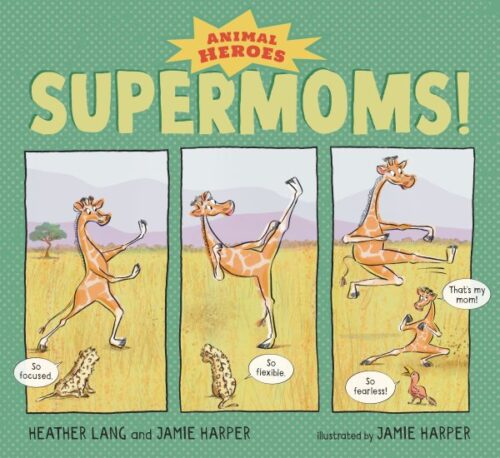
Which animal has the most awesome mom in the world? Penguins or bearded capuchin monkeys? Polar bears or octopuses? With hilarious illustrations and surprising facts, vote for your own favorite! This one slowly grew on me. I think I was ready to jump lump it in with all the other nonfiction animal-related picture books that recount facts under a single overall theme, but something about this particular book stood out for me. Maybe it was the art, and the fact that it does some legit funny jokes in there. Maybe it was the choice of what constitutes a remarkable mom. And maybe it was the additional information in the back, which contains a slew of facts I didn’t know before. Dunno. Whatever the case, it’s distinctly appealing.
Behold the Octopus! by Suzanne Slade, ill. Thomas Gonzalez
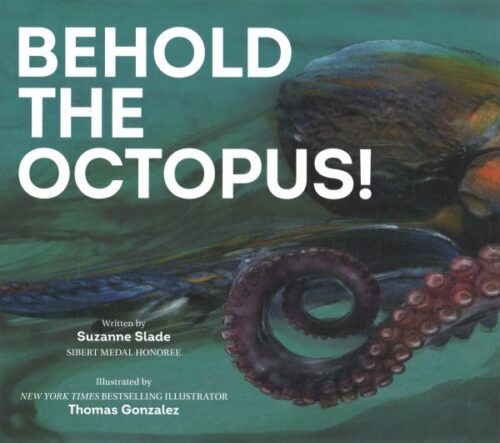
Take a deep dive (literally!) into the wild and wonderful world of the octopus. Sumptuous art pairs with information about everyone’s favorite tentacled ocean dweller. I confess to being rather in love with octopuses from the beginning, so I may not be the most impartial reader of this book. Still, I think Slade does a great job in breaking down all the different kids of octopuses (octopi?) out there in the world. Thomas Gonzalez has always had this lovely style, created with his pastels, colored pencils, and airbrush techniques, and here I really think his talents have been brought to the fore by the subject matter. I like that you can read the big text with younger readers and the little text with their octopus-obsessed older siblings. Plus isn’t that cover great? The octopus shooting past you at lightning speed? This is fantastic. You’ll never get them mixed up with squid again.
Bompa’s Insect Expedition by David Suzuki with Tanya Lloyd Kyi, ill. Qin Leng
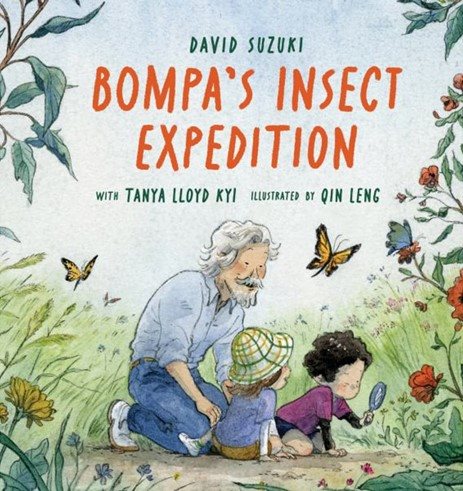
Fictional picture book alert! Twins Nakiina and Kaoru love going on nature expeditions with Bompa but when he suggests they look for insects they’re not so sure it’s a great plan. Haven’t they seen it all? A world of surprises just under your nose. There you go! Young kids who think they’ve seen it all get their eyes opened by their Bompa. I’d cross hot bricks to get my hands on another Qin Leng book, and here she is giving it her all. It’s a truly wonderful title on finding critters in your own backyard (even the sneaky ones). Love the watercolors and the visualizations for some of the kookier ideas (love the ant carrying a stack of backpacks, for example). Extra points for the good strong backmatter and its section on what kids can do to find insects on their own. So cool!
The Book of Turtles by Sy Montgomery, ill. Matt Patterson
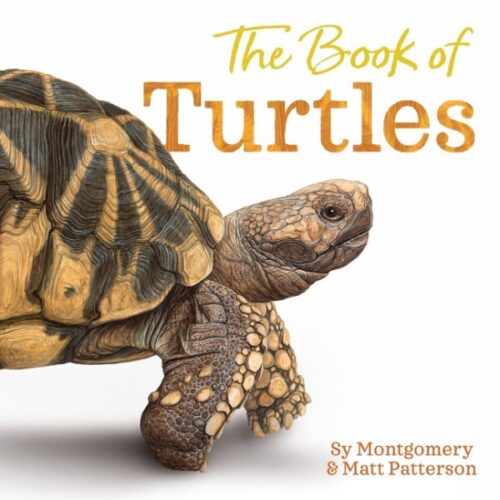
Think you know turtles? Think again! An up-close-and-personal deep dive into a species and all its weird and wonderful qualities. Best. Turtle. Book. Ever. It’s the mark of a great author when they can take a subject that’s been done many times before for kids and reintroduce it in such a way as to make it not just interesting but fascinating. I sort of knew before reading this that a turtle was essentially fused into its shell, but Montgomery gets up close and personal with these creatures, telling you new facts next to old, but remaining consistently interesting throughout. I also knew that some turtles breathed through their butts. I just didn’t know that some peed through their mouths(!!!). Plus the art by Patterson is remarkable. Even if you aren’t a turtle lover, you’re going to be delving deep into this one.
Border Crossings by Sneed B. Collard III, ill. Howard Gray
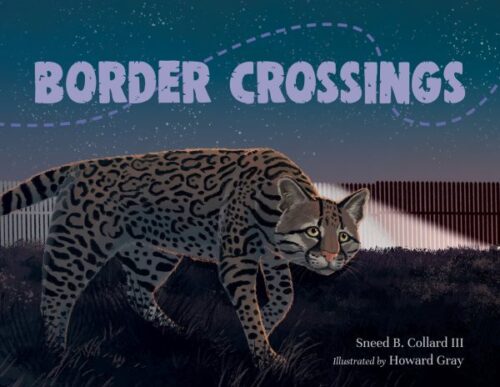
As two endangered ocelots attempt to cross the border, they face obstacles that drive home the catastrophic effects of the Wall–and the many benefits of keeping the border barrier-free. Powerful storytelling introduces young readers to the wildlife that thrives along the border and urges budding nature buffs to value and protect our environment. This is an interesting one. I think Mr. Collard (who’s been in this business for a great many years already) does an excellent job of showing how a wide range of different kinds of animals are inconvenienced at best and have their lives uprooted at worst by border walls between the States and Mexico. He’s an expert at making sure that he ends on a hopeful note, all the while acknowledging the tough facts of the matter.
Can I Recycle This? A Kids’ Guide to Better Recycling and how to Reduce Single-Use Plastics by Jennie Romer, ill. by Christie Young
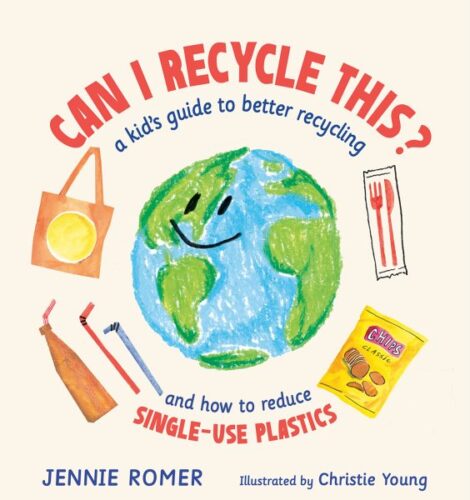
A very pleasant surprise! By gum, you just never know what you’re gonna get when you sign up for reading a picture book about recycling, do you? I mean, this could have gone any which way. As it stands, it really deep dives but in a simple manner, into explaining precisely how recycling works. You get to see the sorting machines and you come to understand that anything that doesn’t fit goes into the trash anyway. I did wish that they’d have shown more human beings involved in the process. As it stands, it does a good job in an area where we just do not hear a lot about logistics. So I’m on board, and I solemnly swear never to try to recycle a plastic fork ever again
Caterpillars: What Will I Be When I Get to Be Me? by Kevin McCloskey
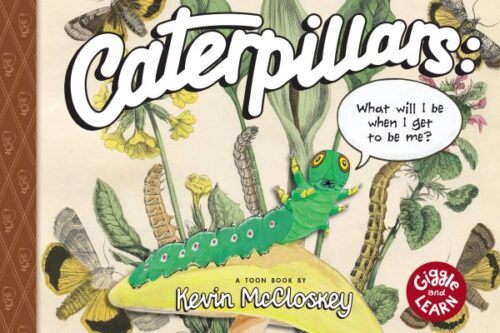
Whether it’s bound to be a moth or a butterfly, the life cycle of these backyard bugs is told with both humor and downright pretty pictures. While normally I’m a heckuva stickler for backmatter, because these TOON Books are meant for earlier readers, I give ‘em a little more slack. Plus, it’s just cute and funny, and we could use a little more cute and funny on these lists these days. This just gives kids a basic Caterpillar 101. The art is a fantastic mix of hyper-realism and a more cartoony style. If we’re talking about finding books that instill a love of nature (and we are) then this instills a sense of curiosity with these particular creepy crawlies. Pairs rather well with the older title What’s Inside a Caterpillar Cocoon? by Rachel Ignotofsky too (which you can see later on this list).
Darwin’s Super-Pooping Worm Spectacular by Polly Owen, ill. Gwen Millward
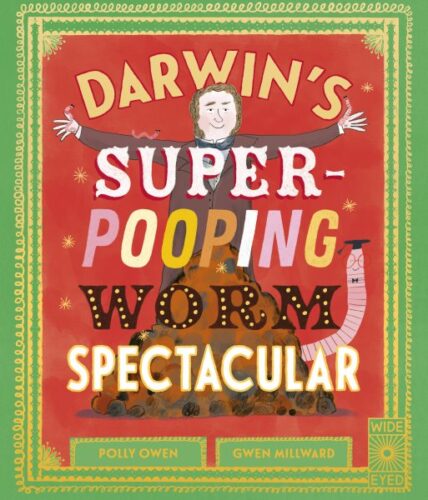
The Victorians were pretty sure that worms weren’t just gross, but utterly useless as well. It took Charles Darwin’s obsessive nature to prove that not only are worms important, but their poop is vital to nature! The most fun you can have with an invertebrate. Man. Polly Owen is toying with me. I’m this hard-nosed stickler for picture book nonfiction, right? I hate fake dialogue. I like my facts to be facts and not suppositions. All that stuff. So she goes and writes a book that is technically all-factual by skirting around the very edge of all my rules. For example, I don’t mind it when dialogue in speech bubbles is fake. Now in this book, Darwin is conducting experiments on the worms. I thought I could safely deem this book Informational Fiction when it showed him playing the piano, fife, and bassoon for the worms. But on the opposite page you actually see this little worm clarifying that, yes indeed, Darwin really did try out all those instruments with his invertebrates. The end result of this is a compelling (and oddly excrement-heavy) bit of good science wrapped in a gross-out package. Gwen Millward is also just going wacky with the art (the bassoon sequence is accompanied by what looks to be a disco floor complete with mirror ball). This is utterly ridiculous and, I’ll admit it, completely within the realm of fact. Kids will dig it (forgive me). Previously Seen On: The Gross List
The Day the River Caught Fire: How the Cuyahoga River Exploded and Ignited the Earth Day Movement by Barry Wittenstein, ill. Jessie Hartland
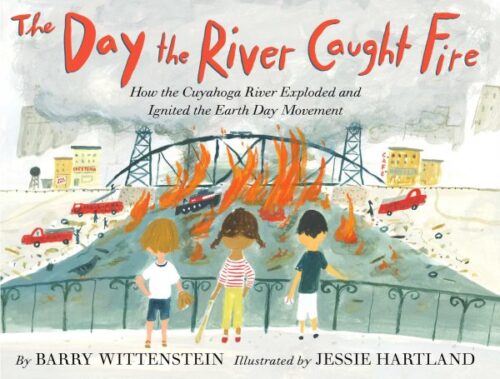
“Wake up, this is not a drill!” By the 1960s the Cuyahoga River in Cleveland caught fire . . . again! Learn how its clean-up helped inspire the first Earth Day in this strange, stinky, (sometimes explosive) tale. And how’s that for an eye-catching title? The joke is that when you read this, there wasn’t just one time the river caught fire but MULTIPLE times that it happened! And people just sort of wrote it off like, “Huh. Guess the river’s on fire again.” Wittenstein and Hartland are having a ball with this book. How could they not? It’s the ultimate example of pollution that’s gotten way out of hand. The kicker is seeing how having a fiery river was normalized until folks finally decided to do something about it. Jessie Hartland’s art style is a perfect companion to this storytelling as well. A fun bit of kooky storytelling about a very real event. Previously Seen On: The American History List
Destiny Finds Her Way: How a Rescued Baby Sloth Learned To Be Wild by Margarita Engle, photos by Sam Trull
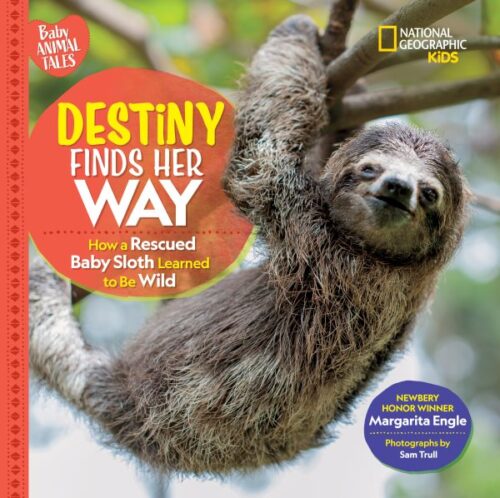
The “Baby Animal Tales” series from National Geographic Kids relies, to a certain extent, on two things: The subject matter and the author. That there will be copious photographs? That’s a given. Of course, it helps each book a great deal if there’s a bit of a story to go along with the cute critters (and up until this moment each one really has been conventionally adorable). Here, Margarita Engle was not present when Destiny’s story was been lived out, but she’s gotten all her information from the people who knew her, as well as this plethora of great photos by Sam Trull. The end result is that you’ve the story of a twin baby sloth who was found at the base of a tree alone, and taken in by an animal rescue center in Costa Rica. The photos are a great lure, but I was particularly impressed by how Engle kept the words concise and limited, to a certain extent. There aren’t big blocks of overwhelming text here. Instead, the font is actually relatively large and the storyline beautifully rendered. As exciting as fiction, but more so because you know that it’s real. Come for the writing. Stay for the photos of little Destiny hugging other rescued sloths because she likes hugging so much. Previously Seen On: The Photography List
Dogs: A History of Our Best Friends by Lita Judge
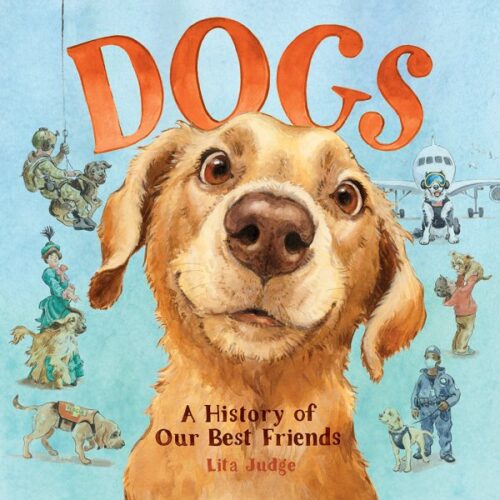
Take a trip back in time to 50,000 years ago and follow the path of humanity’s best friend. From cleaning infectious wounds to clearing birds off of runways, this fact-filled readaloud is a perfect paean to one of our favorite animals. I’ll just throw in the usual caveats. If you know me then you know that I’m completely dog book neutral. Don’t love ‘em. Don’t hate ‘em. Just sorta take ‘em on a case-by-case basis. And this particular case? Probably Lita Judge’s strongest book in years and years. She’s outdone herself here. Like a weirdly large amount of books this year it begins, you guessed it, in the Pleistocene and then goes from there. But the way in which the information is laid out (with longer sections for older dog lovers and shorter sections for reading aloud) is impressive. Plus, I always love it when I learn something from a book. This one taught me that a dog is the only animal that will follow a human’s gaze. Who knew?
Emperor of the Ice: How a Changing Climate Affects a Penguin Colony by Nicola Davies, ill. Catherine Rayner
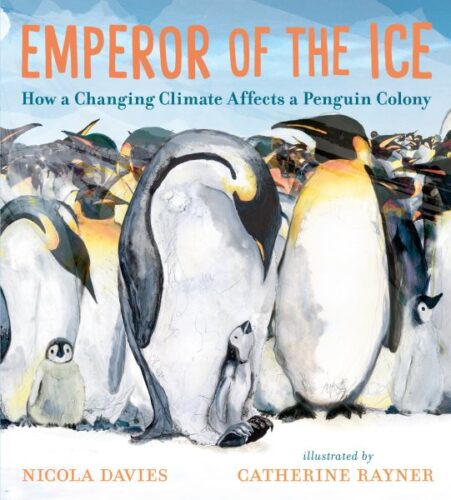
Dang. This is a pretty book. A pretty book and a bit of a departure for Kate Greenaway Medalist Catherine Rayner too. I don’t know that I’ve ever seen her tackle nonfiction before but she does a heckuva gorgeous job rendering the Arctic environment in all its harsh beauty. Now, I know you’ve seen penguin books before. Quite frankly, you may feel a little penguined out. Folks, I’m here to tell you that you have room in that cranium for at least one more penguin book and that penguin book is THIS penguin book. Do you remember how Candace Fleming made us care about bees in a way we’d never cared before in her book Honeybee? This is the Honeybee of penguins. Davies does a brilliant job of putting emotion into the book without cheating or overdoing it. Meantime, Rayner’s watercolors are sumptuous. There’s a particular shot I’m thinking of where you see the line of penguins silhouetted against a blood red sky, and it took all my willpower not to rip out of the book and frame on my wall. A stunner (and there’s even some backmatter to boot!).
Finding Family: The Duckling Raised by Loons by Laura Purdie Salas, ill. Alexandria Neonakis
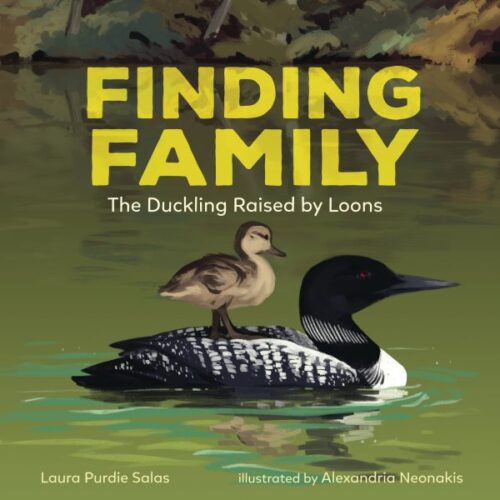
Loons and ducks are natural competitors in the wild, so why did a pair of loon parents raise an orphaned duckling all on their own? A true life story of an unusual family. That the book is well done, there can be no question. I’m beginning to realize that every time I stumble upon a particularly well-written book on a nonfiction subject, I inevitably discover that Laura Purdie was the author in question. The woman just has a skill for making true stories interesting to child readers. I know from experience too how hard it is to take a real life event (loon raises duckling against the odds) and turn it into a comprehensible storyline. This book never cheats, and manages to get a satisfying finish even when no one really knows what happened at the end.
The Fire of Stars: The Life and Brilliance of the Woman Who Discovered What Stars Are Made Of by Kirsten W. Larson, ill. Katherine Roy
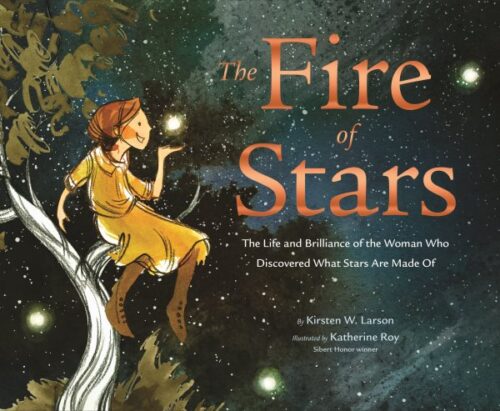
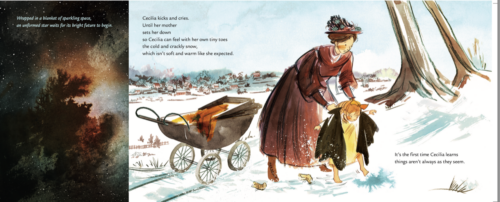
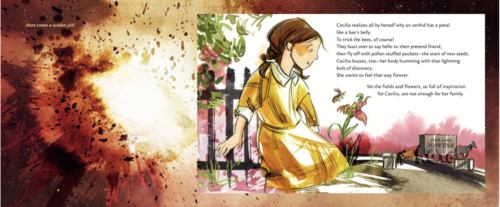
What burns at the heart of a star? The story of Cecilia Payne, ground-breaking scientist, is brought to life in this scintillating picture biography riddled with the mysteries of the universe. In spite of the fact that the subtitle of this book ends with a preposition and completely fails to name its biographical subject on the cover (the longer I look at it, the weirder it gets) this is a stand up and cheer example of how you can take a biographical subject and eschew the rote categorization of their life when you write a book about them. While most picture bios of female astronomers do a dull play-by-play of their life. Larson shakes things up by pairing Cecilia Payne’s discoveries alongside the birth of a star. She has Katherine Roy, science illustrator extraordinaire, there to help her. If you want to have some fun, play attention to how the star information slowly consumes everything behind Cecilia’s biographical history. Also look at how Roy plays with the color yellow in Cecilia’s clothing. No fake dialogue, a surprising story, and great backmatter. Better, by far, than a good chunk of what’s already out there.
Fungi Grow by Maria Gianferrari, ill. Diana Sudyka
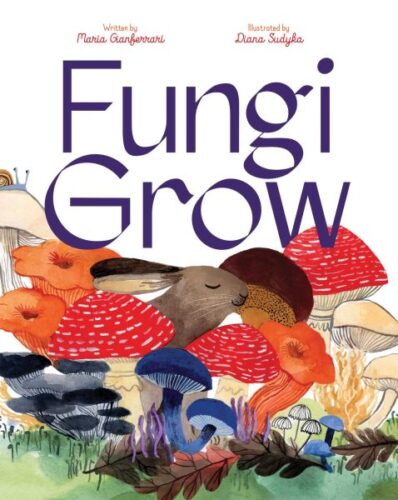
Delve deep into the mysterious world of fungi and all their amazing applications. Their gripping story is paired with the sumptuous, jewel-like watercolors of Evanston artist Diana Sudyka! We’ve seen so many books that talk about tree communication from the trees’ p.o.v. but so few from that of the fungi. This feels like a natural companion to Elise Gravel’s The Mushroom Fan Club, albeit with the beautiful watercolors of Ms. Sudyka. It took me a little while to get into this one since I felt that a lot of the early simple text leans a little too heavily on the more complex small older text portions, but as it continued I thought it really picked up. I was also swayed by all the amazing sections on fungi that can devour plastics and oil. This is a very cool book.
The Gentle Genius of Trees by Philip Bunting
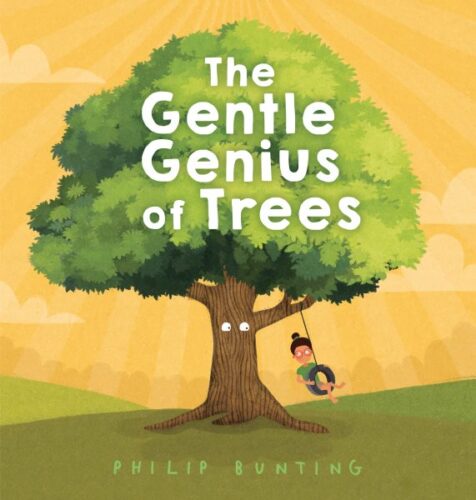
Trees give us so much here on earth but how much do we know about them? Take an irreverent trip into their communication, likes, dislikes, and more. Not the only Phil Bunting book on today’s list, by the way! So I know I was all gaga about a lovely tree-talking book last year (Listen to the Language of the Trees by Tera Kelley, illustrated by Marie Hermansson). Well, that was close to what I was hoping for in a book, but this sort of clinches it. It really makes tree communication a lot more visually clear and clean. Plus the humor just makes it entirely my bag (a tree overreacting to the message that its leaves might be eaten by screaming, “I’m too beautiful to die!”). I sort of adore this.
Glitter Everywhere! Where It Came From, Where It’s Found, and Where It’s Going by Chris Barton, ill. Chaaya Prabhat
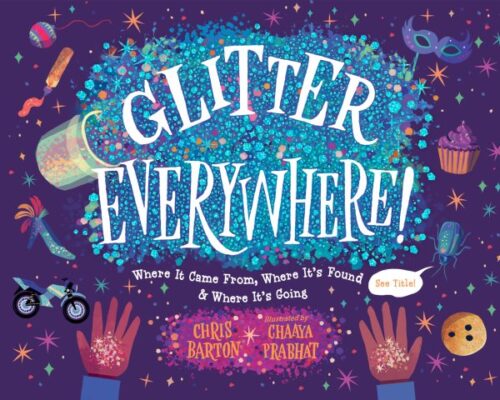
Do you love glitter? Hate it? Then this book is for you! Find out its history, its science, its importance, and what we can do to be more responsible with it so it won’t hurt the environment. If I had the power, I would possibly declare Chris Barton, right here and now, to be the official arbitrator on what does or does not make a conscientious nonfiction picture book. I’ve railed in the past against nonfiction books for kids that skimp on the research, to say nothing of showing their work, but finding examples of the BEST kinds of nonfiction books can be hard. This, however, may fit the bill. In this book Chris doesn’t just give you a rundown of the history of glitter and its problems today, but lets kids in on his research as he goes. When he calls someone by their first names vs. their full names, you find out why. If he can’t find enough evidence to back up a claim, he makes a note of it. He works in science and environmentalism, history and how it relates to Drag performers, and even a bit of math as well. There’s even a note on the front bookflap that reads, “Spoiler alert! Traditional glitter is bad for the planet. That’s why the jacket of this book uses a glitter lookalike.” I’m just blown away. A seemingly silly subject yields one of the best books of the year.
Hidden Creature Features by Jane Park
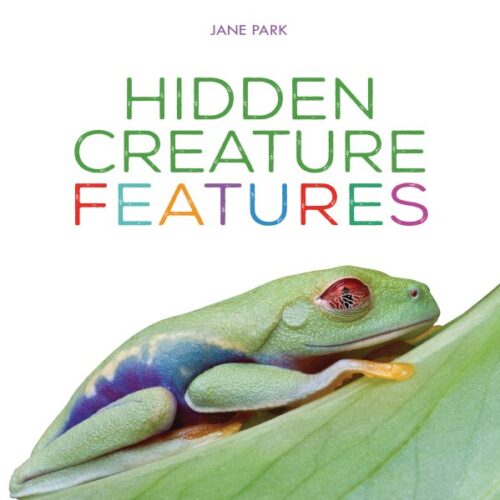
Last year Jane Park blew us all away with her incredible Hidden Animal Colors. By necessity this book can’t quite pack the same visual punch as that title, but it more than makes up for it in other ways. It covers different kinds of adaptations that animals have made due to their environments, eating habits, defense needs, etc. Right off the bat it begins with this incredible shot of a penguin’s tongue that will give me nightmares for years (I knew the tongues had bristles but I think the term “bristles” is insufficient to what that tongue entails). Plus how can you help but love a book that includes a large photo of a “sarcastic fringehead”. It’s like I always say. If you’re going to fill your book with stock Getty images then make sure you get the BEST Getty images. Park delivers and then some.
The High Line: A Park to Look Up to by Victoria Tentler-Krylov
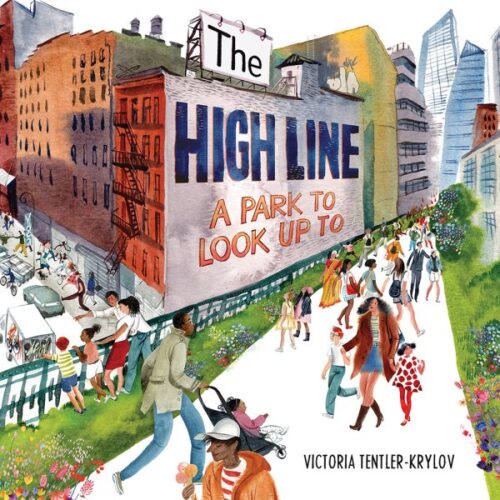
A park in a sky! Sounds crazy, no? But the High Line in NYC is precisely that. See how it came to be, what it’s inspired, and what its future may hold. I may have to recuse myself when it comes to this book since I lived in New York during the early days of the High Line park, and remember many of the details from the time. This isn’t, I believe, the first High Line picture book title we’ve seen, but it is undoubtedly the best. It does its history, sure, but then it goes on beyond that. It discusses other urban park projects inspired by the High Line’s success. And critically, it talks about the problems with the High Line and how it has adversely affected some of the people living alongside its route, which isn’t something you’d see in a lot books of this sort. The watercolors are, for the record, enticing, accurate, and very beautiful. Love the maps, love the backmatter, the Time Line, and really the whole production. You can sometimes tell when a book is a labor of love. This one clearly was.
Hooray for DNA! How a Bear and a Bug Are a Lot Like Us by Pauline Thompson, ill. Greg Pizzoli
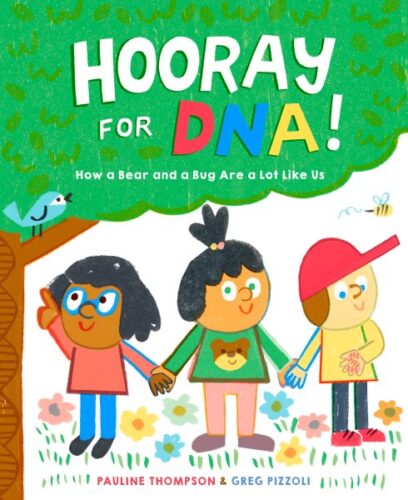
I actually do get asked sometimes to conjure up a list of rhyming nonfiction picture books on a regular basis. It’s not something we talk about a lot in children’s literature, but when it comes to making science and math accessible, I think it really helps adults out. Not kids. I honestly believe that they’re a lot more open to those subjects than their gatekeepers. So add a little cadence and a little rhyme and boom! Instant adult interest. Now I love DNA and I love the art of Greg Pizzoli, so getting the two together here seems equally logical and inevitable by turns. Thompson, for her part, does a great job at trying to break down this concept into its simplest terms. But I know what you’re thinking. You’re wondering, “Betsy, I’m happy to hear that the rhymes are strong and the science sound, but what’s the backmatter like?” You’re probably not actually asking me that, but you should because this backmatter (all of two pages) is fantastic! Info on DNA for older readers, a Bibliography of books, videos, and websites, and even a little “DNA Scavenger Hunt” where you can find out how much shared DNA we have with a range of critters and other living things. Worth the price! Previously Seen On: The Rhyming List
How the Sea Came to Be: And All the Creatures In It by Jennifer Berne, ill. Amanda Hall
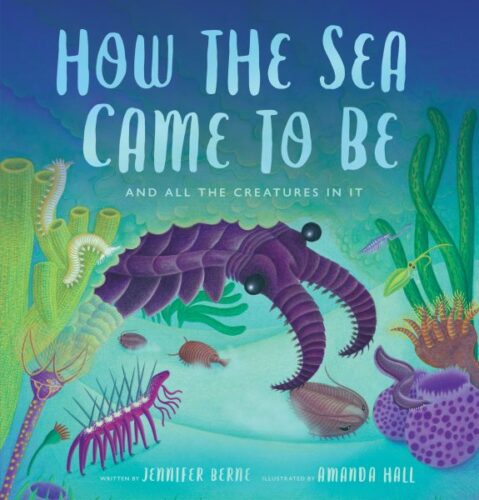
Boy, you could make an amazing list of books discussing the early beginnings of life this year if you really wanted to. Consider a unit that included this book and We Go Way Back by Idan Ben-Barak (found later on this list). In this case, Hall leans hard into depicting the beauty of an early Earth, forming out of heat and explosions. The watercolor, gouache, pencil crayon, pastels, and digital materials really do a marvelous job of bringing that boiling, hissing and then cooling and raining world to life. Here the tiny stirrings of life are depicted as white against a variety of different kinds of blue. Further on, the colors just pop on the page, looking strange and wonderful and alien. Extra points for a gatefold backmatter (never seen THAT before!) depicting a kind of pie chart, sorta, of the eons from Hadean to Cenozoic. Not to say that the rest of the backmatter (and it’s a LOT) isn’t great too. It’s just an original way of tackling a subject that needs little creativity on the page to make it pop.
How to Bird by Rasha Hamid
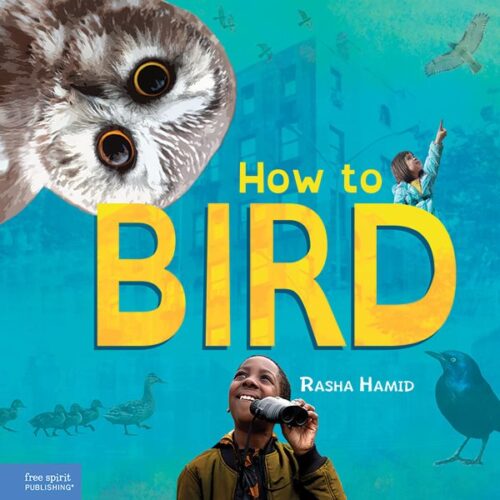
“Are you a birder?” Good news. Anyone can bird! Let this joyful little book be your guide with vibrant photographs and a heaping helping of enthusiasm! Folks, I just seem to keep finding great books. This latest is no exception. Here we have a book that makes it clear that any kid, anywhere (but particularly if you’re in the city) can be a birder. The birds that they show are indeed of the city (though I might take issue with the fact that they call the sparrows in the book “house sparrows” which are an entirely different breed). The photographs are a ton of fun, a mix of photos takes by Ms. Hamid and some other folks and iStock photos. But really I just love the energy of this book. If any book is going to make you want to run out the door to spot a birdie, this is the one. Previously Seen On: The Photography List
How to Eat in Space by Helen Taylor, ill. Stevie Lewis
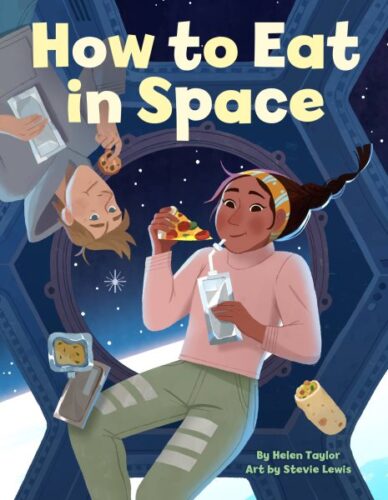
Think eating in space is easy? Think again. Use this guidebook to food in space. What works, what doesn’t, and how to make more. Reminds me a bit of last year’s wonderful (and wonderfully gross) young reader’s edition of Packing for Mars. The art gets the job done, and I really like the text and the layout of the information here. It goes through a practical understanding of what it would take to eat in space in a clear and realistic way. The book probably missed a couple opportunities for fun facts (example: the whole reason we even know that tortillas are perfect space food is that we started sending someone other than white men into space). But I just really think kids are going to get a kick out of this. It’s fun and funny at the photos at the end are a thrill. And yes. It’s also gross. Previously Seen On: The Gross List
I’m Trying to Love Germs by Bethany Barton
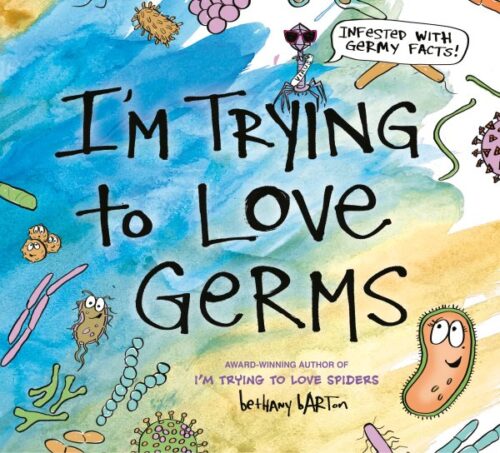
Some nonfiction with your picture books? Absolutely. Any book that can claim to be “infested with germy facts” by a virus wearing red sunglasses is probably going to be worth your time and investment. Not that this is Barton’s first time at a rodeo. Or second. As it happens this is the sixth entry in the “I’m Trying to Love” series, following books dedicated to spiders, rocks, math, garbage and bees. But as a small microbe at the beginning of the book is quick to point out, the title of this book is all wrong. It should be called “I’m Trying to Love Microbes”. Aside from teaching me things that I actually did not already know (I’m particularly interested in bacteriophages now, as it happens), the book’s a hoot. Extra points for the moment when it compares germs to glitter (“Imagine if when you coughed or sneezed a whole bunch of glitter came out”). Funny and informative, but not in a gross way. Previously Seen On: The Funny List
If the Rivers Run Free by Andrea Debbink, ill. Nicole Wong
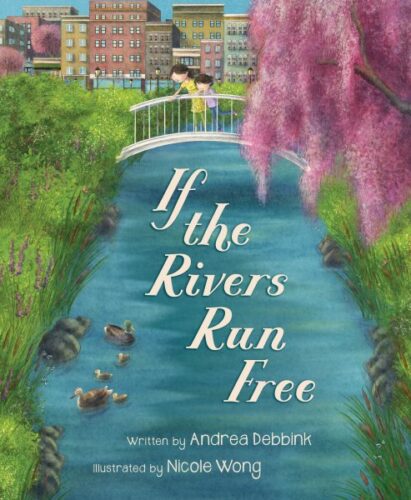
Could a river be running just under your feet and you don’t even know it? Come see how cities have trapped rivers for years and are only now allowing them to be free. Such a neat concept for a book. I grew up in Kalamazoo, Michigan (which gets a shout out at one point in this text) and while I was there I do remember learning that the city was partially built over a river. But that’s just such a weird concept for a kid to even try to understand. How do you build over water? The idea that a large body of it might be moving under your sidewalk is difficult to visualize. Debbink, much to her credit, figured out that my childhood confusion could indeed be the confusion of other kids as well. Plus, since I was a kid, a number of cities have “released” these rivers, so to speak, and let them free. This book explains why they were trapped in the first place, the environmental problems that came with those choices, and which cities have made strategic plans to allow them to be free. I would have liked a slightly more rigorous bit of backmatter (the book includes some additional river info but is utterly bereft of a bibliography or sources). Otherwise, it’s a neat title, helped in no small part by the art of Nicole Wong.
Jumper: A Day in the Life of a Backyard Jumping Spider by Jessica Lanan
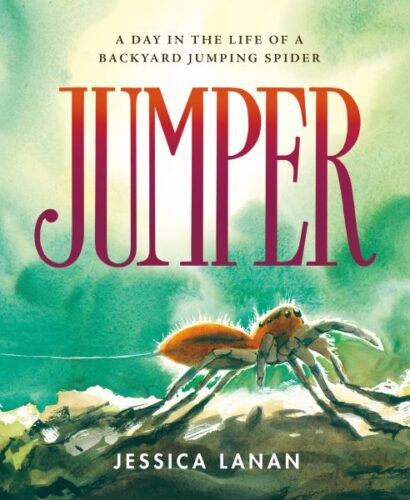
What’s it like to be a spider in the grass? Enter the world of a jumping spider and experience the danger and excitement happening just under your nose. Does anyone remember the picture book The Lost Package that came out a year or two ago? I was just so taken with Jessica Lanan’s watercolors there. Of course, she’d been doing nonfiction for a while anyway (Just Right: Searching for the Goldilocks Planet was great too) but I truly feel that Jumper is a standout in the field. First up, some spider identification backmatter, to say nothing of the Glossary and Resources and general info on spiders themselves. I love how she’s laid out the story so that you get that spider’s eye view through the lens of how it moves, feels, jumps, hears (I always wondered how they heard without ears), and (most gloriously of all) sees. There’s a pull-out double fold spread in this puppy that will blow you away. If I had my way, this would be a Caldecott winner. Fantastic. And you haven’t see what a book looks like under its cover until you’ve seen this Tiktok video by Ms. Lanan.
The Last Plastic Straw: A Plastic Problem and Finding Ways to Fix It by Dee Romito, ill. Ziyue Chen
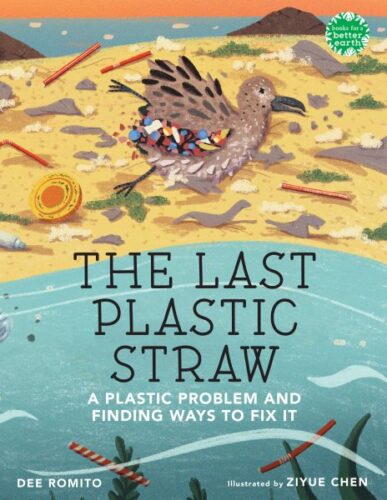
Dive deep into the history of straws to see where they came from, the problems they create, and what you can do to help save the environment from them. I’m seeing a really nice trend this year in our environmental picture books. They seem to be following a fairly standard form, but within their borders they can go any number of creative ways. As per usual, this book goes through the history of straws themselves, offering a worldwide tour of them from Sumer to South America to China. The art is a fascinating mix of illustration with the odd jolt of photography in there sometimes as well. By the time it gets to the environmental impact of straws, you see this nice combination of nods to kid activists, alternative sustainable straws, and some fantastic backmatter. A smart take that I’m a little surprised no one’s done in a picture book before.
Matter (Hands-On Science) by Lola M. Schaefer, ill. Druscilla Santiago
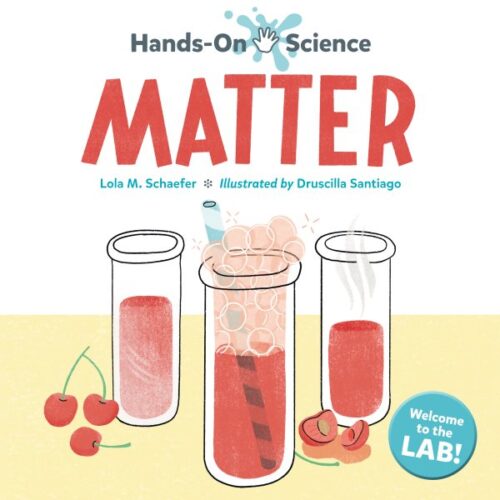
Considering how long ago Press Here came out, it’s funny to me that only this year did we finally see some books that took the “interactive picture book” model and started to have a little more creative fun with it. One book out this year was This Book Is Banned, on the fiction side. And on the nonfiction side we’ve a title that takes interacting with science and puts it on the page. Set in a chemistry lab, the book says “Here you can have fun exploring matter.” This means doing some amazing work with cherries. These solid substances are squished and tilted, jiggled and blown, and in the course of things you get to examine gasses and liquids as well. Schaefer’s an old hand at the picture book game, and I think that experience is part of what makes this book work as well as it does. There’s even a little science experiment you can do with your adult that involves baking soda and lemons. It’s a pretty neat intro to science and experimentation, and a heckuva lot more fun than just reading about it on the static page.
The Mellons Build an Eco House by Robin Jacobs, ill. Nik Neves
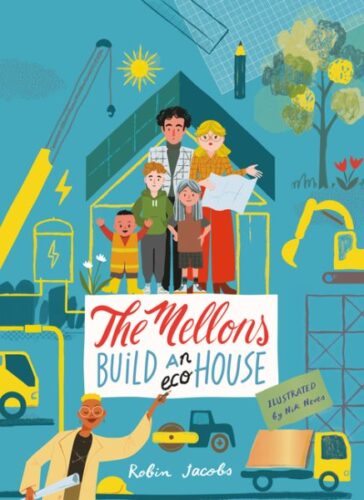
When the Mellon family can’t find the right house they decide to build their own! And with the help of architect Masha, this is going to be the most sustainable house you’ve ever seen. I have to say straight off the bat that I do have to approach this book with some mild trepidation since I worry that part of the reason that I like it so much is that I’m an adult. Would a kid be quite as into this tale of building a house as me? Maybe! I remember years ago the Jonathan Bean book Building Our House and how into it my kids were. Plus there’s something really cool about getting to plan your own room, or ask for stuff like a pool (which, to the book’s credit, they don’t exactly get). The one thing about the story that makes me nervous is that the architect decided it would be a good idea for these folks to keep bees. Sure hope they had a conversation about this before the beehives arrived! Otherwise, this may be one of the MOST forward thinking eco-friendly titles I’ve ever seen.
Moon’s Ramadan by Natasha Khan Kazi
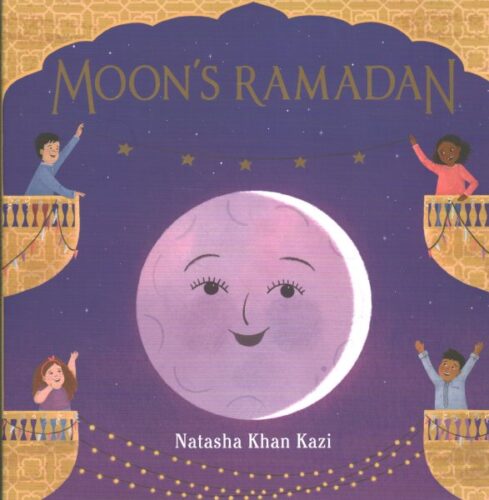
This year I started doing a little freelance work for an educational organization that likes to find science books for a range of ages that also show a range of experiences. And let me tell you, if they ever ask me to recommend books for younger ages that discuss the moon’s cycles alongside holiday celebrations, I know precisely what book to bring up. In this story the moon watches as her cycle influences worldwide celebrations of the month of Ramadan. As she waxes and wanes, we learn a little more about how people celebrate in a wide range of different countries. It all ends with Chaand Raat and the beginning of Eid. Copious backmatter includes an Author’s Note, info on the Lunar Cycle (WITH a small Bibliography, thank you very much), and then a Glossary of Ramadan terms. It’s just an exceedingly clever way to talk about the holiday with a little bit of science mixed in there. A friend of mine saw this book and asked if there was any book that talked about how important the moon is to so many different holiday celebrations around the world. Not yet, but I’d say this book is a pretty good start. Previously Seen On: The Holiday List
Nature Is a Sculptor: Weathering and Erosion by Heather Ferranti Kinser
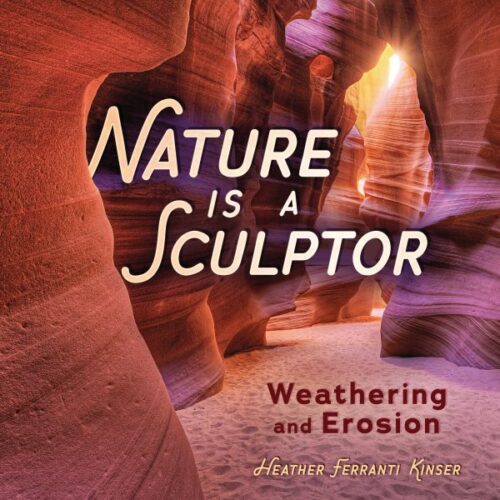
Take a trip to national parks and landmarks to learn about all the different ways that nature designs some of the most beautiful landscapes. My sole objection to this book is that every time I see this title I start singing “Rhythm is a Dancer” for some reason. Not the book’s fault, I suppose. I’m a sucker for gorgeous photography and how can you possibly resist the shots they’ve included here? More to the point, Kinser has taken this mass of information about weathering and erosion and organized it into a comprehensible and understandable format. The rhymes are also accomplished (which is always a relief). “The ocean is a hammer / pounding shorelines into bits. / Ice – a chilly chisel – finds a crack, / expands, and splits.” Very cool. Previously Seen On: The Photography List
Nature’s Rule Breakers: Creatures That Don’t Fit In by Jessica Fries-Gaither
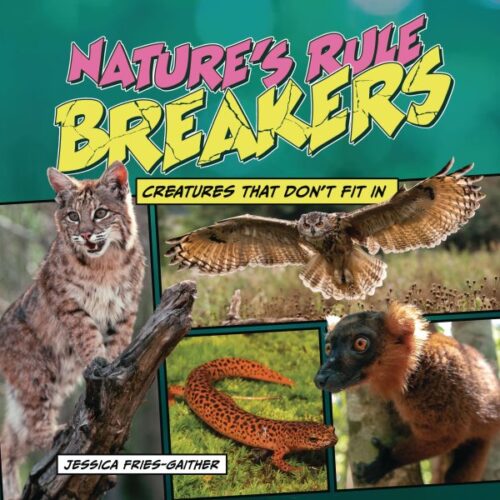
I’m the not only one who hears an x-treme guitar riff when I read this title to myself, right? Thought so. And you know, in spite of a title font that feels like it escaped from a 1988 Just Say No campaign t-shirt, I do believe that Milbrook knows what it’s doing when it combines a design that’s inviting with facts that many kids (and more than a few adults) won’t know. For example, were you aware that giraffes chew on bones? I only did because there was an internet meme about it a couple months ago, but this book covers the facts (we don’t have carnivorous giraffes taking down animals, they just need the minerals in the bones to stay healthy). Or how about the fact that the sockeye salmon can live in both fresh water and salt water over the course of its life? This is a book that shows that every time we come up with a “rule” for animals (like you have to be either male or female) there’s going to be an exception (like the garden snail, the bearded dragon, and the clown fish). And I don’t think I need to tell you how important it is to teach kids that there are few absolutes when it comes to biology. Nature? It finds a way.
Night Owl Night by Susan Edwards Richmond, ill. Maribel Lechuga
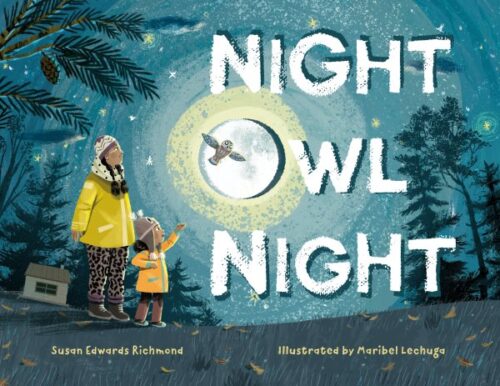
All Sova wants is to finally see a saw-whet owl. Her mom’s a scientist and they’re hoping to measure, weigh, and mark one, but this is when Sova must learn an important truth: A scientist must learn to wait. If ever I decide to create a picture book list of books that teach patience, this may be right up there at the top. No kid could read this book and not sympathize with Sova. We get these ideas of what scientists do and how exciting it all is, but nature doesn’t follow our schedules. Richmond nails that feeling, while Lechuga does a stellar job with the art. There’s this shot of Sova reflected in the eyes of the owl which may be one of my favorite illustrations of 2023 too. A lovely paean to both patience and science in equal measures.
Not a Monster by Claudia Guadalupe Martínez, ill. Laura González
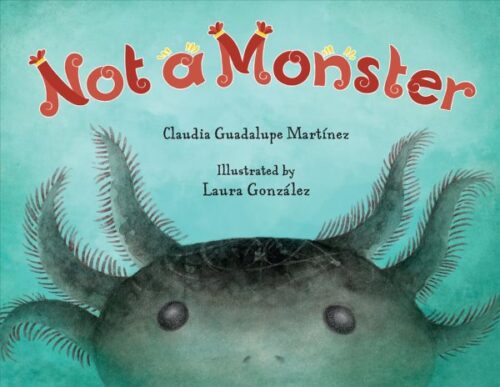
Young nonfiction. It’s easy to overlook. We adults gets so enamored of stories where the text is long and complex, but what about the little nonfiction lovers? Where are their books? They’re out there but too often they just don’t get the same amount of attention. Now this duo of Martínez and González previous did a rather charming book a couple years ago called Not a Bean. I sort of love that the natural successor to beans is, of course, monsters. Axolotls, if we’re being precise. The watercolors in this? González outdoes herself. Luminous is an overused word by reviewers like myself (I may have already used it earlier on this list today) but doggone it. This thing is filled with luminosity! Cute backbatter, though I could have used a tiny bibliography. Otherwise, no notes. This is one of the best axolotl books I’ve seen in a long time.
One World: 24 Hours on Planet Earth by Nicola Davies, ill. Jenni Desmond
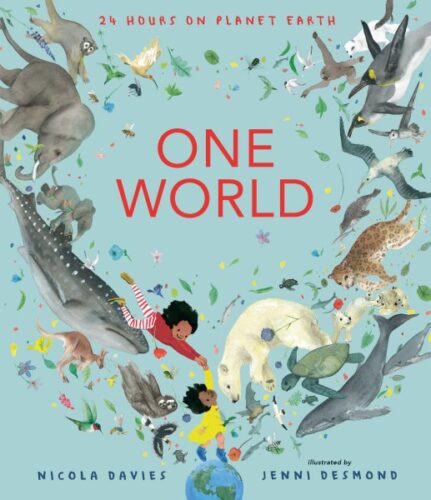
Take a trip through the time zones! When it turns midnight in London, what’s happening at the exact same time in wildlife all over the world? A call to action for our beautiful worldwide environments. I’ve seen books that show different time zones all around the world before, but this is the first time I’ve seen one that does it strictly through the eyes of wildlife. The environmental message is worked into many of the images, and Davies & Desmond do a good job of changing up the landscapes and ecosystems from page to page. The danger with a book of this sort is that it may come across as a bit preachy, but that’s where the time zone conceit is so helpful. By using that as the method of traveling around the world at the same bong of the bell, you’re able to show how all this change is happening at once. Plus I liked that in the backmatter at the end there’s a section on “What Can People Do to Help?” It’s purposeful, but it works within its own conceit.
One Tiny Treefrog: A Countdown to Survival by Tony Piedra, ill. Mackenzie Joy
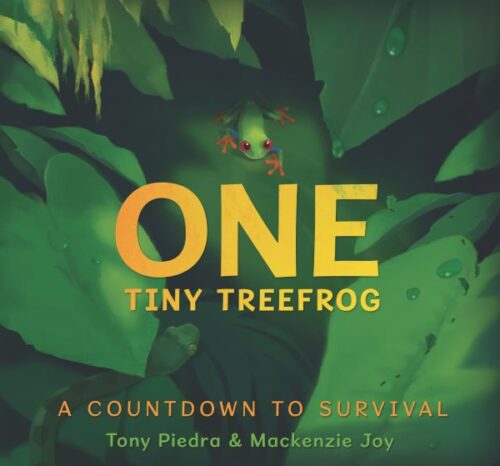
“Ten tiny tadpoles grow in their eggs.” Count down as each tadpole falls prey to hungry nature in this eye-opening look at not just treefrogs but survival of the fittest as well. Nature red in tooth and claw, indeed. This book effectively combines two of my favorite things: picture books in which the protagonist gets eaten and nonfiction titles that show nature being nature. And while I wouldn’t want to necessarily read a book that discusses how mama hamsters sometimes eat their own young, this book about a rapidly diminishing number of baby treefrog tadpoles explains quite efficiently why it is that a great number of animals in the world create as many babies as possible. You really don’t actually see any of these froglets die (though there is one moment that comes close) and I love the surprise ending. I wouldn’t give it to one of the more tenderhearted children out there, but I love the backmatter, and animals included, and the way in which it chooses to convey its material.
Santiago Saw Things Differently: Santiago Ramón y Cajal, Artist, Doctor, Father of Neuroscience by Christine Iverson, ill. Luciano Lozano
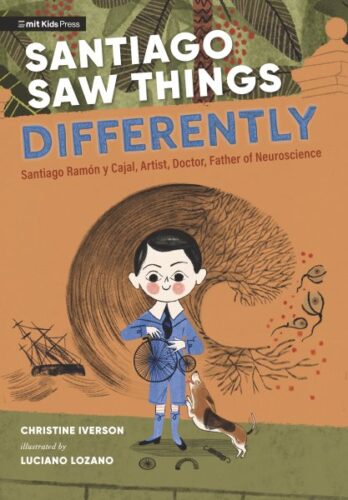
Now, to be perfectly fair, any book that has to follow the graphic biography Santiago! Santiago Ramón y Cajal – Artist, Scientist, Troublemaker by Jay Hosler has a tough road to hoe. The advantage that Iverson and Lozano have here is that while that book was a comic for older readers, this is quite clearly a picture book biography. As such, it eschews some of the violence of Santiago’s life (and does not begin, as Hosler did, with its titular hero getting kicked in the head by a horse… or was it a mule?). Here, it’s a rather visually stunning encapsulation of the life of a boy who was able to combine art and science in a way that made difficult concepts clear to others. Forced by his father to study to become a doctor rather than an artist, it was Santiago who figured out how to sketch nerve fibers. Lozano does a beautiful job of incorporating Santiago’s own art into the art of the book, while Iverson deftly synthesizes his sometimes wacky life into something clear and concise. Gotta say, it’s a pretty good looking book.
A Shell Is Cozy by Dianna Hutts Aston, ill. Sylvia Long
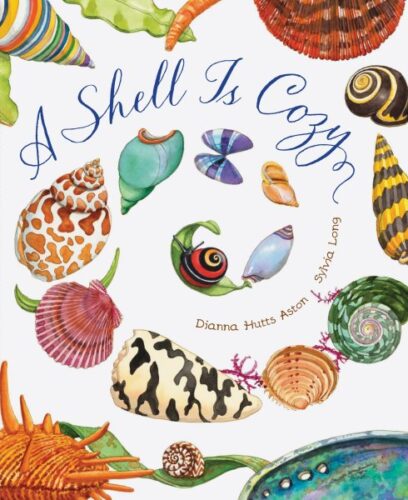
You know, if a format works, it makes a lot of sense to stick with it. I remember way back in 2006 when An Egg Is Quiet by this duo first came out. It was just the nicest little look at. The white background allowed Sylvia Long’s delicate watercolor illustrations the chance to really show all kinds of seeds waking up, doing their thing. Aston & Long followed it up with A Seed Is Sleepy (200&7), A Butterfly Is Patient (2011), A Rock Is Lively (2012), A Nest Is Noisy (2015) and A Beetle is Shy back in 2016 and that, pretty much, was the end of that. Now after a number of years they’ve returned with a look at shells. And doggone it if it isn’t just as good as everything else. Better even, maybe. There are cool interior looks at what the inside of a mollusk’s shell looks like. There are deep vibrant colors and unusual details (love the candy cane snails in the trees). I’d just listened to a podcast about the terrifying poisonous snails, like the marveled cone, that may hold the keys to multiple cures to human diseases, so this fit in well. Long gone are the days when the pages were pure white. Long is having a lot of fun with beautiful sunrises and sunsets, blue seas, and pink skies. I particularly adored the rendition of Watts Towers in L.A. as shown here. It may be part of a series, but this is a true standalone winner.
Stone Age Beasts by Ben Lerwill, ill. Grahame Baker-Smith
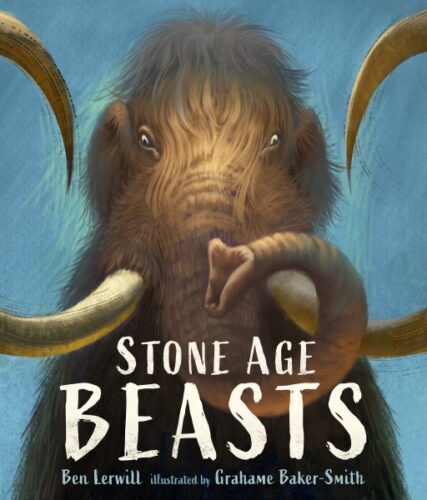
Oo! I like this move on Grahame Baker-Smith’s part towards nonfiction. Granted, this is an English import, and you know how the Europeans are about backmatter (which is to say, they don’t really believe in it). But this is a little better than the norm! We at least have a Glossary of Terms. No timeline. No Bibliography. But hey, baby steps, people. We’ll take what we can get. Besides, the trade-off is getting to see how Baker-Smith renders a giant short-faced bear, a giant short-faced kangaroo (what was it with huge ancient animals and short faces?) or, my personal favorite, the gigantopithecus (which I don’t think I’ve ever seen in a book for kids before). Each page has one of those fun sidebars showing how tall an average human was when compared to each of these animals, plus info on where they lived, how much they weighed, and when they became extinct. And believe me when I say that we might be very glad indeed that some of these critters aren’t around anymore (I’m looking at you, European hippo).
A Stone is a Story by Leslie Barnard Booth, ill. Marc Martin
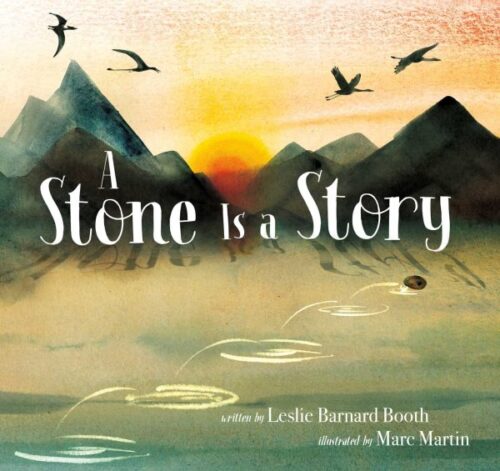
“Where do rocks come from?” The answer may be more incredible than you think! Embark on a journey across time to see how one stone can change and transform, from magma under Earth’s crust to the sand swept up by a rushing river to the very heart of the tallest mountain. Oh yeah. Yeah, this is a pretty one. Just a great use of watercolors to bring out the sheer beauty of rocks, of all things. Love those watercolor striations in the valleys. Plus, this is a great example of everyday science for kids that aren’t necessarily living in the country. Anyone can find a rock after all, right? Love the info and, yes indeed, adore that beautiful backmatter. This one’s a keeper.
Stranded! A Mostly True Story from Iceland by Ævar Þór Benediktsson, ill. Anne Wilson
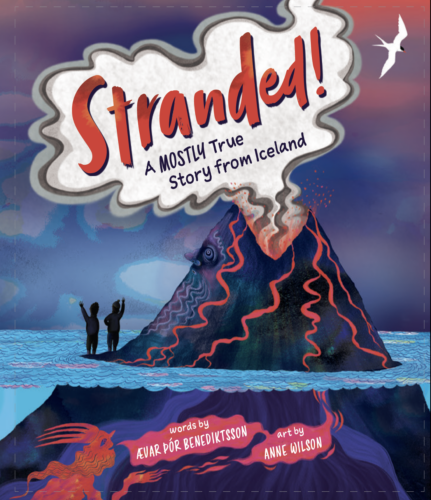
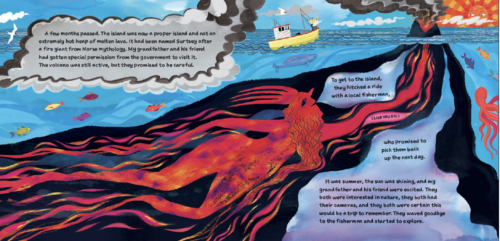
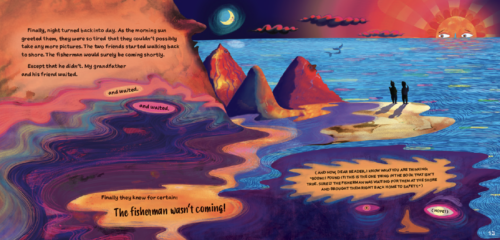
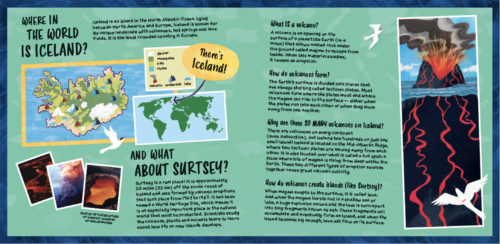
Almost all the facts in this book are true. Can you find the single lie? When the author’s grandfather got stranded on an active volcanic island with this friend their survival was NOT guaranteed. An unexpectedly hilarious and harrowing tale. Kooky little bit of writing, but I think it’s that kookiness that makes it work. First and foremost, this is really very funny. I think that there’s a lot to be said for authors writing stories about their grandparents’ stupid stupid decisions. About the point the glasses have melted, you are ON BOARD with this book. And the fact that you just happen to learn a lot about volcanoes and Iceland (and I’m grateful for now always knowing how to pronounce “Ævar”) is just the icing on the cake. A delightful read! Previously Seen On: The Funny List
Super Small: Miniature Marvels of the Natural World by Tiffany Stone, ill. Ashley Spires
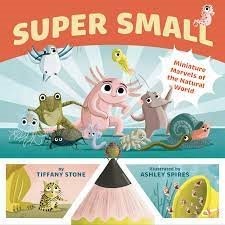
So many choices must be made when someone wishes to set critters of any type to verse. In this case, we’re getting downright wee, and it’s a pleasure to mark the return of Ashley Spires (who knows how to depict creepies and crawlies expertly). I appreciated that the title included lesser known creatures, like the ageless hydra, as well as some of the better known, like (once more) the axolotl. But considering how often I learned something in this book, you can bet that kids will too. The verses explain what each creature’s super ability is. I was just a bit sad that there wasn’t any additional backmatter to give more info on these critters (or sources to check if you wanted to learn more). Still, I’ll forgive a lot for Ashley Spires. Wouldn’t put it in your poetry section, though. Be sure you catalog this one in the 500s.
Thank You, Moon: Celebrating Nature’s Nightlight by Melissa Stewart, ill. Jessica Lanan
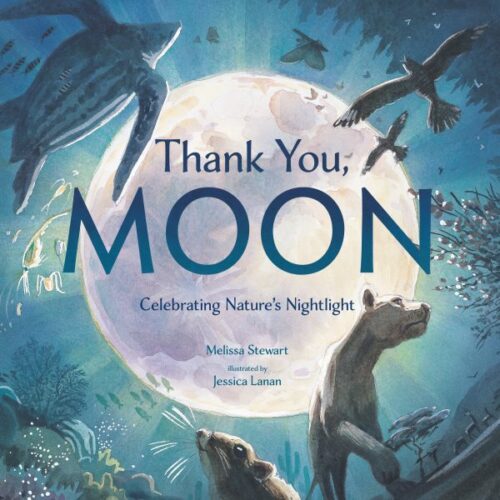
A clever look at what the moon does and how it affects different kinds of life on Earth in different ways. From fish to fowl, bugs to zooplankton, this is a charming look at how everyone needs our closest neighbor in the sky. Stewart does a great job of peppering the text with all these little facts that I simply didn’t know. I mean, I knew that the moon kept Earth’s rotation steady. What I did not know was that without the moon the Earth would grow too hot or too cold for life to be sustained. Fun! It does a great job of varying all the different animals, plants, insects, fish, etc. that rely upon the moon in different ways. Lovely art (it’s Jessica Lanan again, so what else could you possibly get?) and a cool premise.
Tumble by Adriana Hernandez Bergstrom
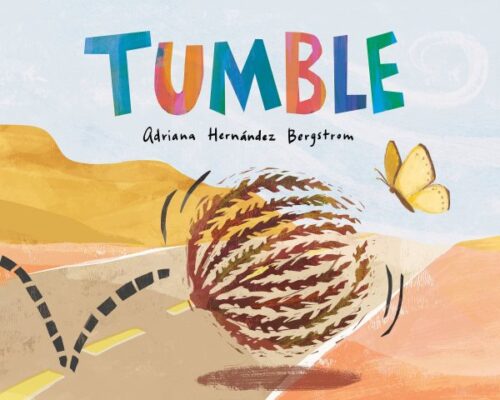
This is a pretty good example of a book that I dismissed out of hand the first time I read it, then did a complete 180 on later. Credit my co-worker Martha Meyer with that little turnaround. First off, this is one of those incredibly rare simple picture books. I often find that such books are incredibly difficult to find. So it has some real readaloud potential, but then there’s the science behind the story. How much do you actually know about tumbleweeds? As a Midwesterner, I’d never encountered one in real life, but watching their eerie life cycle is really eye-opening. I had a co-worker say that they particularly enjoyed it as someone who has tried to move a tumbleweed in the past. Science and simplicity all in one. Previously Seen On: The Simple List
We Go Way Back by Idan Ben-Barak, ill. Philip Bunting
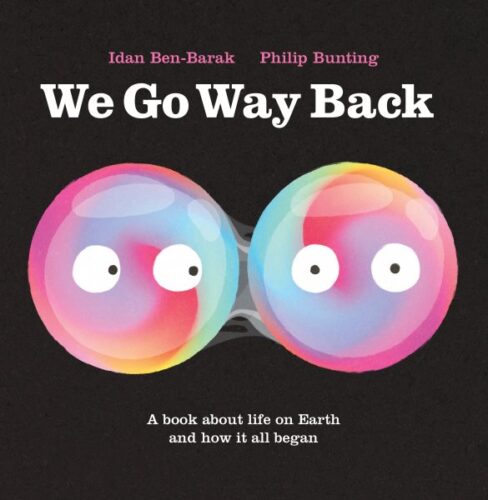
What is life? Where did you get yours from? And how did it all start? A funny but accurate look at the beginnings of life, from atoms and elements to the creatures we have today. You know how sometimes rock stars form supergroups together? I feel like picture book authors and illustrators sometimes do the same thing. This book’s a good example of that. You have Idan Ben-Barak, who was one of the authors of Do Not Lick This Book and then you have Philip Bunting who’s behind the aforementioned The Gentle Genius of Trees, together for a story about how life began. And believe me, I’ve read a lot of books on the subject, but this is the first I’ve seen to show the elements forming the molecules and the molecules forming the bubbles that became cells. I love how visual this is! Bunting should get extra credit for that family tree fold-out section. Examine it for a while, if you can. He had to make a lot of distinct choices there. And, as is right, I love the googly eyes on everything. Everything is better with googly eyes.
What’s Inside a Caterpillar Cocoon? And Other Questions About Moths and Butterflies by Rachel Ignotofsky
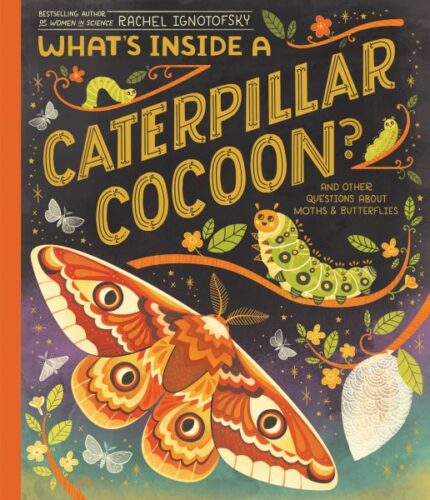
How are moths and butterflies related? What goes on in a cocoon or chrysalis? Immerse yourself in this gorgeous and informative deep dive into what makes these creatures some of the most fascinating in the world. Beautiful books have burned me before, so I didn’t necessarily trust this book when I first encountered it. I mean, sure, its cover glows with pretty gold foil and the art inside is nothing short of amazing, but usually this kind of book has huge chunks of immovable text that is so hard for a kid to want to read, unless they’re friggin’ obsessed with the subject matter. But this book? The perfect amount of text! What’s more, a very systematic and informative series of pages about the differences between moths and butterflies. That art really is as beautiful, as I mentioned before, and then at the end you get a small bibliography of sources, and resources for kids to help butterflies and moths on their own. It’s informative and, best of all, has a lot to say about helping the Earth. I kinda love it.
When Moon Became Moon by Rob Hodgson
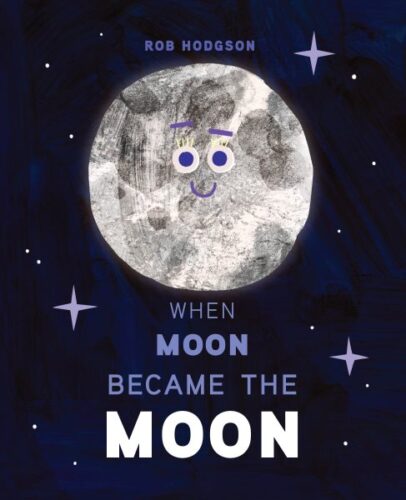
As he did for clouds, so too shall he do for the moon. Rob Hodgson first appeared on my radar when he created the greatest water cycle picture book of all time, When Cloud Became a Cloud. He just has this way of turning complicated science concepts into ideas so simple a young elementary school reader can understand them. With his sights now resting entirely on the skies, Rob does something right at the start of this book that I really appreciated. He manages to show how the moon formed in a concrete and understandable way. First, he shows how Earth crashed into “another early planet”. The rocks that came out of this zoom around her gravity. Then, “Some of the rocks were so excited to be together that they got closer and closer, and hotter and hotter, until… They came together to form a moon.” This is shown so simply and clearly and I really appreciated its inclusion (other books on this subject sometimes elide this part of the process or skip over it entirely). I also appreciated that throughout all of this, the Earth is not depicted as blue or anything. You’d be amazed how many books discussing early Earth do this. The rest of the book covers the tides, keeping the Earth steady, seasons, eclipses, you name it. If you could have only one book for younger kids on the moon, I think you’d want it to be this one.
Whose Prints? by Kari Allen, ill. Kim Smith
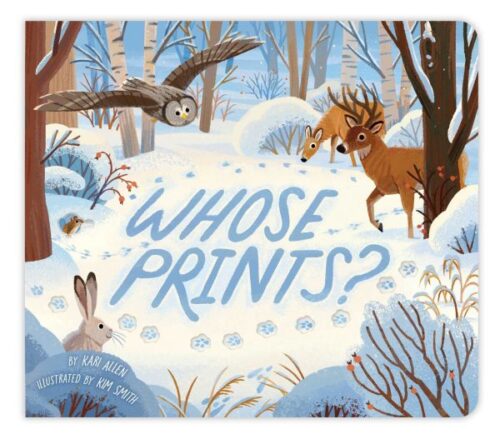
There are lots of tracks in the freshly fallen snow, but who made those tracks? See if you can identify them in this bouncy, rhythmic, tactile and early introduction for the youngest of readers. I see a lot of science-y board books in a given year and they always seem to make the same mistakes. Either the text is too wordy or there aren’t any interactive elements or the facts are a bit squidgey. And I sympathize, because it must be very difficult making informational books for our youngest of readers. What I like so very much about Whose Prints?, though, is that it manages to maintain that simple text and simple concept (identifying different animal tracks in the snow) while also giving little kids a tactile, physical thing to do (the tracks are all die-cuts in the page). It’s fun, simple, and allows the parent to make fun sounds like, “Slink, slink, slink,” or “Hop, Hop, Bounce, Burrow,” as well. A winner! Previously Seen On: The Board Book List
Why Do Elephants Have Big Ears? Questions – and Surprising Answers – About Animals by Steve Jenkins and Robin Page
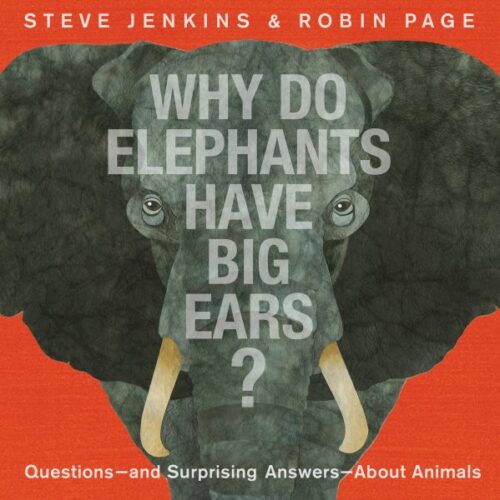
Aw, Steve. We miss you, dude. Nobody made a book like Steve Jenkins (except, of course, Robin Page) and so it’s nice to see the last of his titles trickling out here. It also helps that his books remain just the best at what they do. This particular outing explains a couple animal adaptations, some of which you adults may already know about (why do camels have humps?) and some may strike you as original (why do wombats even have cube-shaped poop?). It’s always interesting to consider the fact that if this were the very first Jenkins/Page book out there, it would be praised and hallo-ballooed to the hills. As it stands, he was just too good at what he did, and too prolific. Like his other books, you’ve the cut paper critters, a size comparison silhouette to show how much larger or smaller each creature is compared to humans, and then extensive backmatter that gives you even more information. PLUS a Bibliography. A class act, through and through.
You and the Bowerbird by Maria Gianferrari, ill. Maris Wicks
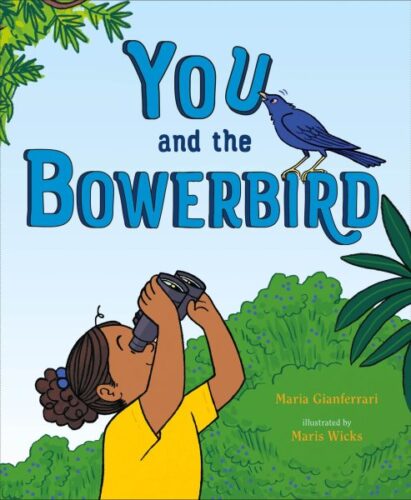
What bird designs its bower with objects that are a favorite shade of blue? The bowerbird, of course! Watch it design, arrange, and defend its creation, all in the name of love. I’ve been a huge fan of Maris Wicks since I first stumbled on her independently published picture book comic Yes, Let’s more than a decade ago back in NYC at MOCCA. She’s done a lot since then, but pairing with Gianferrari is not the career move I would have predicted. Gianferrari is usually writing alongside the hyper-realistic Bagram Ibatoulline types. Still, Wicks’ silly, almost cartoonist, style is a perfect accompaniment for this explanation of how bowerbirds design their bowers. I like it when nature gets silly on me. This book is silly, and then some!
2023 Science and Nature Books for Older Readers
At Home with the Prairie Dog: The Story of a Keystone Species by Dorothy Hinshaw Patent, photographs by William Muñoz
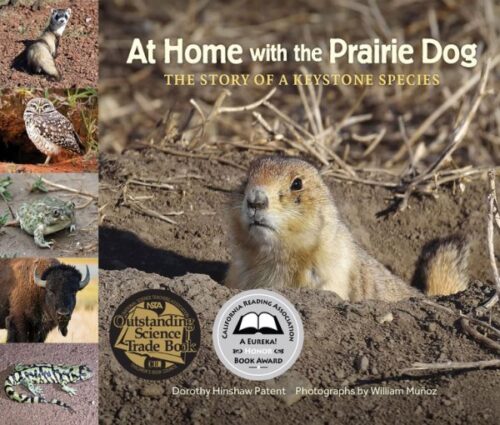
What’s a keystone species and why are prairie dogs so incredibly important to the prairielands? Take a trip down into their burrows and learn how these necessary animals keep at least 150 species healthy and thriving. This is great. I wasn’t in love with the font, but that’s the harshest thing I can say about the book. If you’re looking for a picture book that really defines what a “keystone species” is by showing rather than telling, this is the book you want to have in hand. Patent cleverly intertwines a prairie dog’s everyday existence with the lives of so many other critters and species in the prairielands. I also appreciated the photography at work here, and completely understand why they had to supplement Mr. Muñoz’s work with shots of other Getty images n’ such. All told, this takes something cute and makes it pertinent.
Big Tree by Brian Selzick
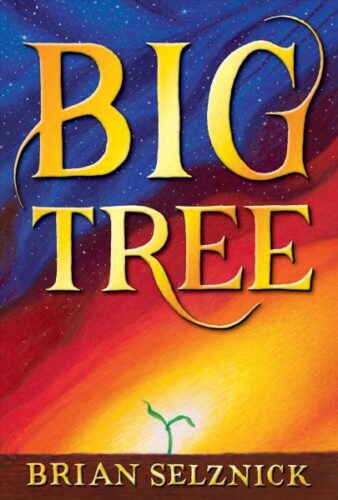
Fiction Alert! Two little seeds set forth to find their destiny in a great big world. But how can creatures so tiny expect to save life itself? A cinematic plunge into a whole new world. Well, it’s quite the thing all right. Honestly, my bar for it was pretty low since I’d heard some mixed things about it late last year. As it happens, it’s rather nice. It’s essentially what would happen if Steven Spielberg read this year’s The Gentle Genius of Trees and tried to turn it into a cinematic epic. Selznick works his magic too. I liked his art (as ever) and I liked the main characters in the story. It’s definitely a bit of a quixotic journey, and it gets a little bit much for me near the end, but generally speaking there’s a lot to enjoy.
Breaking the Mold: Changing the Face of Climate Science by Dana Alison Levy
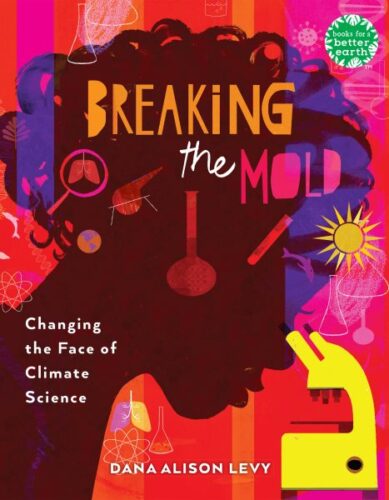
Join more than 16 scientists, some BIPOC, some differently abled, but all working to fight climate change, as they tell about their personal journeys and how they “broke the mold” on who gets to work in science. Hey, this book is pretty darn good! Mind you, it’s definitely on the upper end of my spectrum. Feels a bit like it’s best intended for high schoolers, but a kid worried about what occupation they might have someday could get something out of it as well. They did a much better job at the design of this book than some other similar ones I’ve seen. I’m all for it. A win!
Chloe’s Nature Journal by Miri Leshem-Pelly
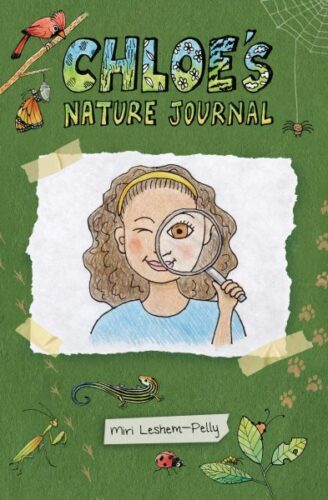
Think that there aren’t any animals in your backyard? Think again! Join Chloe as she uses patience and observation to locate and draw the myriad wonders working hard where no one else is looking. Okay, folks. You want a hand-on early chapter book about a girl getting up close and personal with nature itself? This is burgeoning scientist matter at its best. In fact, it almost feels calculated to get kids to follow in Chloe’s footsteps, recording their own observations in the mini wild. I like the design that feels a mix of notebook novels and fun science. It’s not what I would call a plot forward book, but that’s not really its point. Extra points for “The Seven Principles of ‘Leave No Trace’” found in the back of the book. I’d encourage parents to purchase this and give it as a gift alongside an empty journal. Previously Seen On: The Early Chapter Book List
The Deep! Wild Life at the Ocean’s Darkest Depths by Lindsey Leigh

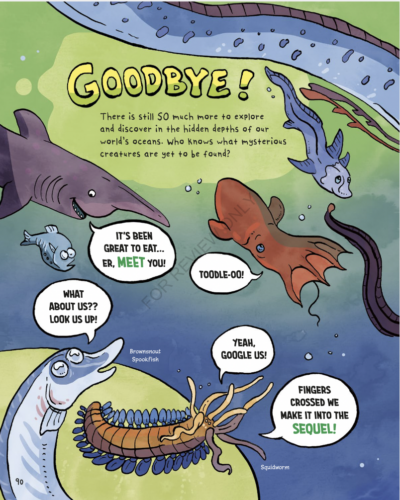
Sink deep deep below the waves to meet the creatures that dwell where nothing else can live. A fantastic voyage filled with humor and facts we can guarantee you never knew before! Ahhh. So this is what I’ve always wanted in a deep sea book for older kids. And no shade on the other whale fall book out this year, but I guess I had sort of hoped that that book would have the sheer levels of excitement and interest that this one has. Fashioning her style on old 1950s B-movie posters, Lindsey Leigh packs her book with hilarity and solid factual information. I learned a LOT from this title. Somehow, Leigh manages to sandwich the less interesting info between the fascinating and funny (as well as gross) stuff so beautifully that it’s irresistible. A must read! Previously Seen On: The Funny List
Drawn to Change the World: 16 Youth Climate Activists, 16 Artists by Emma Reynolds
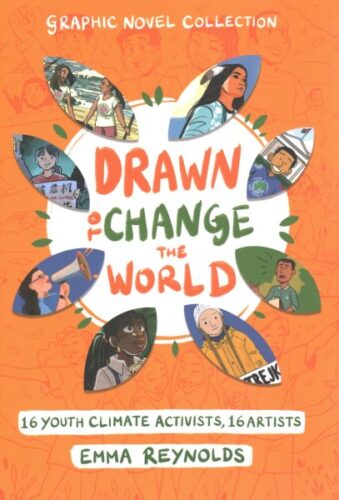
Can young people make a difference for the environment? These 16 kids did. Watch via these comics their struggles, beliefs, and triumphs in this unique group biography. I suppose we could debate at length whether or not this book goes into the nonfiction section or the graphic novel section, but I’ll put it here. This shows kids taking charge without, I think, instilling in them any particular fear. Even when awful things happen to them (like getting arrested by the Chinese government) the book sees no need to dwell on those moments. Now I did find myself wishing that there had been 16 authors as well as 16 artists at work here, but I guess for the sake of continuity it makes sense. Even so, I feel like Reynolds definitely put more time into some of these activists (like Dara McAnulty) than others (like Leah Namugerwa). Overall, however, it’s strong and it does one thing that I have never seen an environmental book for kids do: It shows that the whole “your Carbon footprint” idea was started by corporations who wanted to distract people from the fact that they are the world’s biggest polluters. That’s huge! So there’s a lot to love here.
The Forest in the Sea: Seaweed Solutions to Planetary Problems by Anita Sanchez
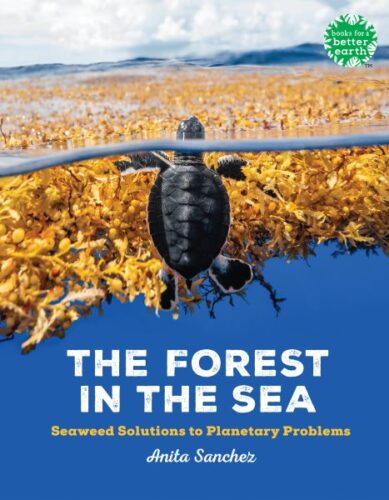
It seems ridiculous that the slimy seaweed you see wash up on beaches could be key in fighting climate change, but it’s true! Find out its numerous amazing (and often delicious) uses! It’s interesting! But, as so often happens, I have to figure out if it’s interesting to me as an adult or interesting to kids. The book’s job is to lure in child readers that might not come to its pages already kooky for seaweed. It starts off strong, no question, but does bog down a little from time to time. Fortunately they break up the text with the little sidebars. I liked the focus on the farming and the uses of seaweed. It has some really strong pages. Deserves to be seen by those kids with an eye to solutions for the future.
The Great Giraffe Rescue: Saving the Nubian Giraffes by Sandra Markle
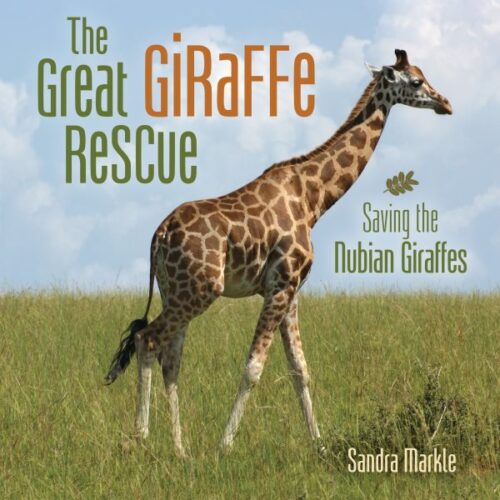
So very well done! It’s certainly a title for older readers, but it doesn’t bog you down with endless pages, coming in instead at a handsome 40. I was particularly intrigued by the fact that the efforts in this book weren’t focused on moving ALL the giraffes out of a region, but a significant number that could increase their numbers over time. LOTS of lovely photographs, which I always enjoy, and Markle even managed to include a kind of giraffe hero into her story (Melman, the giraffe with a kind of wonky jaw). Accessible and cool with a larger message about how we have a tendency to ignore danger to different species until it’s too late.
Hidden Systems: Water, Electricity, the Internet and the Secrets Behind the Systems We Use Every Day by Dan Nott
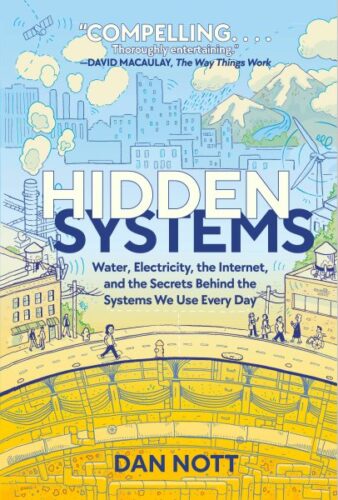
“Huh, I actually have no idea how the internet works.” “And wait… is there really enough water for everyone all the time?” “And what’s really powering this light? What even IS electricity?” If you’ve ever found yourself asking even one of these questions, Dan Nott has provided a book that is nothing but answers. As he mentions early on, a hidden system is something we don’t notice until it breaks. They’re also supremely hard to visualize, so a graphic novel format actually makes for the perfect vehicle for explaining not simply the mechanics, but also the history, the inequities, and how these systems must be updated in the future if we want to sustain them. I’ve been joking to folks recently that David Macaulay must have retired this year or something since the man has been on a blurbing bender. That said, this book is the PERFECT vehicle for a Macaulay a.k.a. “The Way Things Work” blurb. Just as Macaulay broke down the construction of cathedrals, pyramids, and more, so too does Nott break down whole systems we rely on. And I don’t care how much you think you know about these three things. You’re bound to learn something incredible on almost every page. For example, did you know that the lines that carry our internet follow the exact same paths as the lines that carried telegraph messages originally? An utterly fantastic and fascinating book. Definitely on the upper end of middle grade, but for a savvy reader there’s a lot to be interested in.
The Language of Plants: Understanding How Plants Communicate by Darya Beklemesheva, ill. Helena Haraštová, translated by Mark Worthington, edited by Scott Alexander Jones
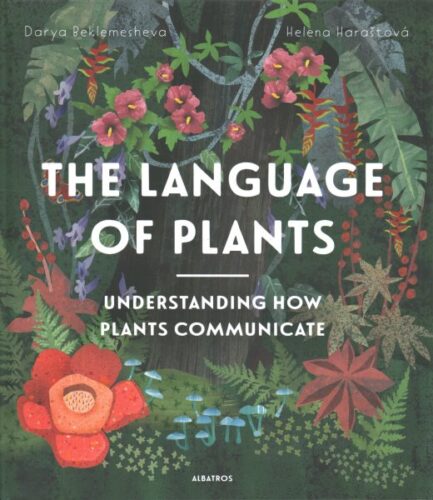
While I’m not the biggest fan of its design, there’s no denying that Russian Beklemesheva knows how to pluck out the most interesting facts for kids on a topic they may or may not have encountered before. The book is separated into interesting sounding sections with names like “Life-or-Death Struggle” and “No Stress”. Within those sections, the Table of Contents show how they are broken down even further. For example, under the chapter heading “Mighty Scents” are the three sections “Can a plant kill an antelope?”, “How do plants warn each other?”, and “Why do caterpillars get upset tummies?” Extra points to translator Mark Worthington for getting some nice nuances of language in there. Meanwhile there are some truly gripping stories inside. The antelope section, for example, reads like a murder mystery. In the 1990s, kudu antelopes were dying in large numbers on South African wildlife reserves? The culprit? Their acacia trees had become toxic, and trapped as they were on the reserve, the antelopes couldn’t get far enough away to avoid the leaves. Full of fun facts, this is for the plant nerd (but with clever booktalking I bet you could get other kids interested as well).
The Miracle Seed by Martin Lemelman
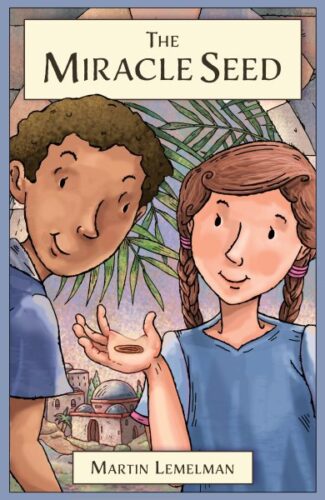
Everyone knows that the Judean date palm went extinct long ago, right? But when scientists were given 2,000 year old seeds, they decided to see if they’d grow. A tale of history, science, and delicious dates. Sometimes you gotta sit on a book a while to understand what you think about it. I’ll confess that I wasn’t originally going to put this book on this list when I received it. I liked it, but was it memorable? So I put it down for a week or two . . . and kept on thinking about it. Seriously, it’s amazing how many times I’ve found myself thinking about its implications. For example, I recently was listening to a podcast that was discussing the now extinct plant silphium and found myself wondering what would happen if someone managed to find some silphium seeds. With its panels, speech balloons, and other elements you might find in a comic book, the information here is incredibly accessible for kids. I like how Mr. Lemelman also managed to work in Jewish history as well as the science necessary to understand WHY a seed this old could still be viable. Absolutely fascinating.
Unseen Jungle by Eleanor Spicer Rice, ill. Rob Wilson
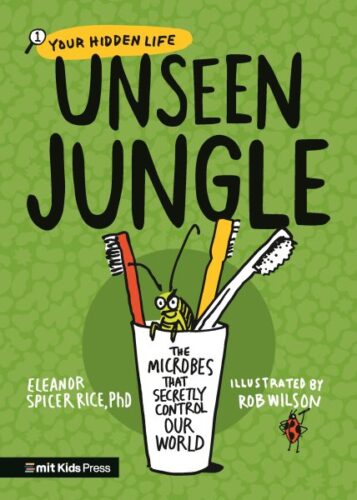
Whether you’re an up-and-coming young scientist or just want a book with the grossest stuff in it, there’s a lot to love in this compendium of microbes and their unseen, highly disgusting, world. Sorry, folks. I hate to be the one to break the news but I found myself a nice super gross book for 2023 and I’m loving it. What’s the name of the game this time? Microbes! Specifically bacteria, fungi, protozoa, archaea, algae, super-tiny animals, and viruses (though Rice acknowledges that some scientists would say they don’t count). The book then systematically goes through every possible place you might encounter them. It gets two germ-encrusted thumbs up from me on the “yuck” factor, but you also learn a TON of info. For example, this may be the first time I’ve ever felt bad for flies. Read the book. You’ll see why. Previously Seen On: The Gross List
We Need to Talk About Vaginas: An Important Book About Vulvas, Periods, Puberty, and Sex! by Allison K. Rodgers, ill. Annika Le Large
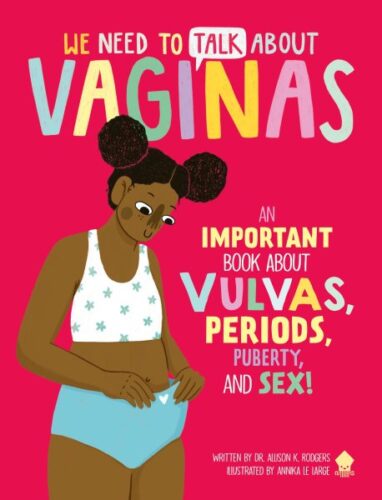
Straightforward information about everything from puberty and pregnancy to consent, presented by a gynecologist who knows exactly what questions people with vulvas might have about their changing bodies. And here we come to the complicated question of what to do with a book that is more of a straightforward informational text than anything else. A necessary book? And how! Lord, I don’t think I saw any of this stuff in a book until I went to college and my roommate handed me Our Bodies, Our Selves (am I dating myself much?). Kids today are so lucky. This book does a pretty good job of remaining aware of bodies along the LGBTQIA+ spectrum, while also offering straightforward information in a clear cut way. It’s not a particularly creative book or pretty book in that way, but boy am I glad that it’s now in this collection!
Hope you enjoyed these! Here are the lists you can expect for the rest of this month:
December 1 – Great Board Books
December 2 – Picture Book Readaloud
December 3 – Simple Picture Book Texts
December 4 – Transcendent Holiday Picture Books
December 5 – Rhyming Picture Books
December 6 – Funny Picture Books
December 7 – CaldeNotts
December 8 – Picture Book Reprints
December 9 – Math Books for Kids
December 10 – Gross Books
December 11 – Books with a Message
December 12 – Fabulous Photography
December 13 – Translated Picture Books
December 14 – Fairy Tales / Folktales / Religious Tales
December 15 – Wordless Picture Books
December 16 – Poetry Books
December 17 – Unconventional Children’s Books
December 18 – Easy Books & Early Chapter Books
December 19 – Older Funny Books
December 20 – Science Fiction Books
December 21 – Fantasy Books
December 22 – Comics & Graphic Novels
December 23 – Informational Fiction
December 24 – American History
December 25 – Science & Nature Books
December 26 – Unique Biographies
December 27 – Nonfiction Picture Books
December 28 – Nonfiction Books for Older Readers
December 29 – Audiobooks for Kids
December 30 – Middle Grade Novels
December 31 – Picture Books
Filed under: 31 Days 31 Lists, Best Books, Best Books of 2023
About Betsy Bird
Betsy Bird is currently the Collection Development Manager of the Evanston Public Library system and a former Materials Specialist for New York Public Library. She has served on Newbery, written for Horn Book, and has done other lovely little things that she'd love to tell you about but that she's sure you'd find more interesting to hear of in person. Her opinions are her own and do not reflect those of EPL, SLJ, or any of the other acronyms you might be able to name. Follow her on Twitter: @fuseeight.
ADVERTISEMENT
ADVERTISEMENT
SLJ Blog Network
Name That LEGO Book Cover! (#53)
Exclusive: Vol. 2 of The Weirn Books Is Coming in October | News
Fighting Public School Book Bans with the Civil Rights Act
Take Five: Middle Grade Anthologies and Short Story Collections
ADVERTISEMENT

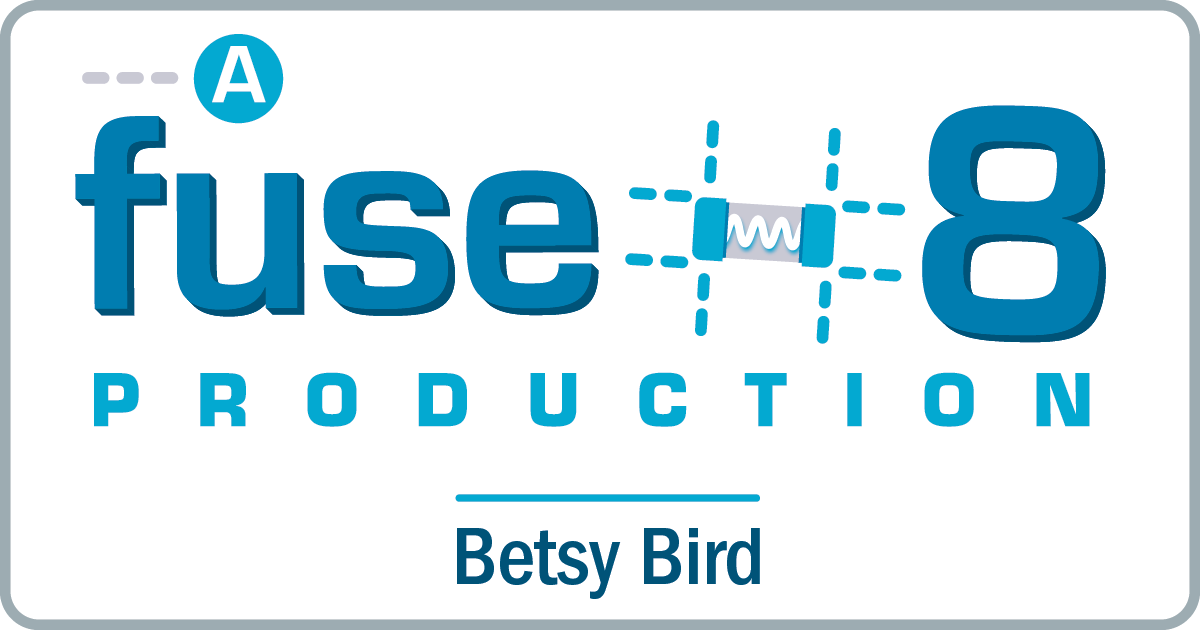

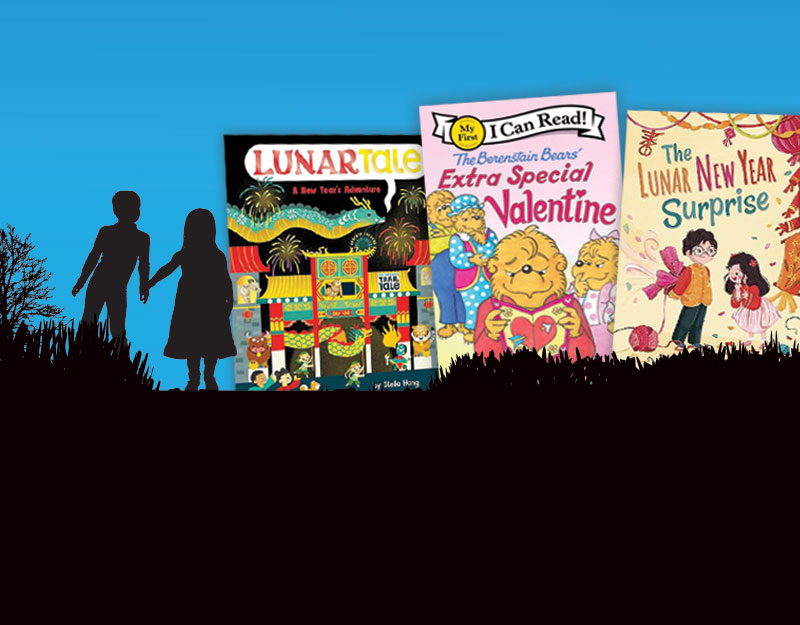
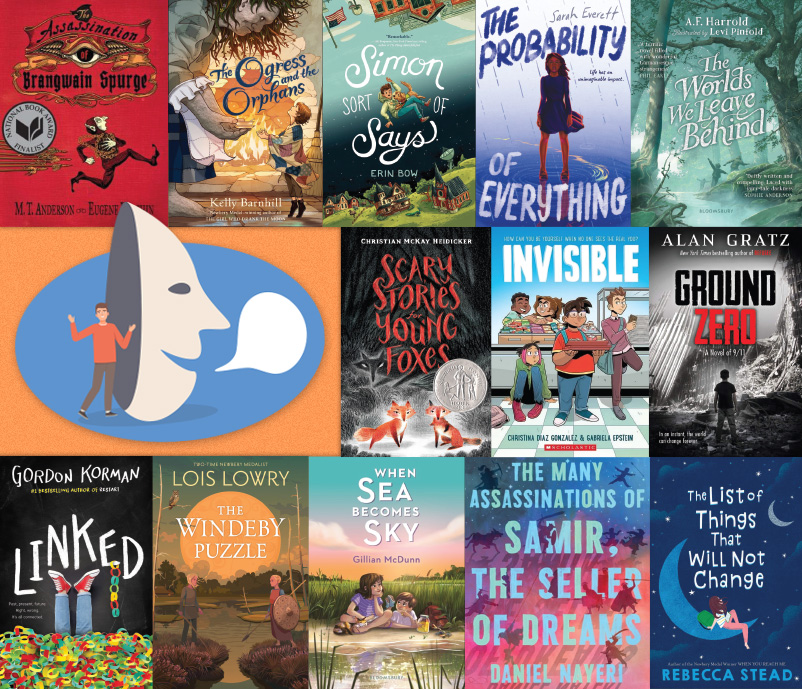
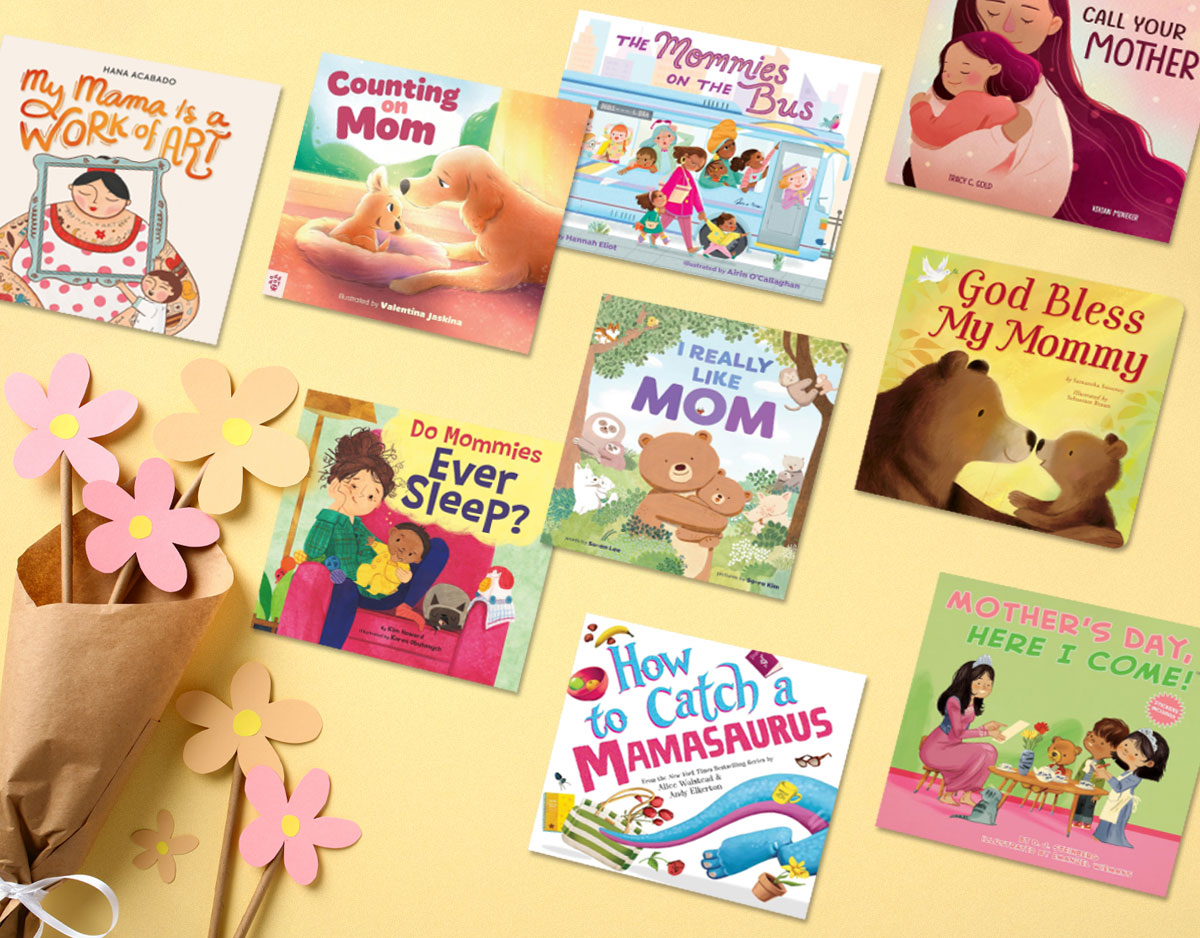
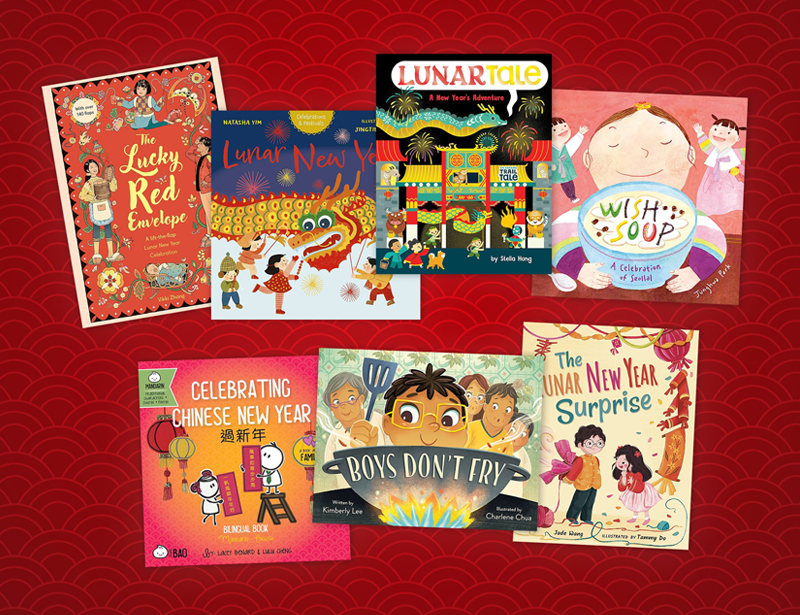
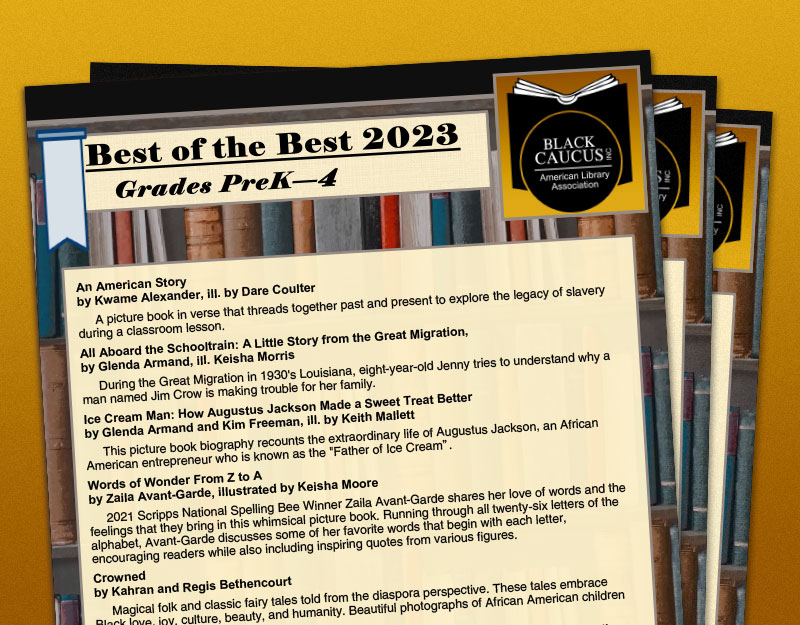
I counted 63 titles on this list. Just scrolling through the cover images so far, I’m speechless. Here we are at a time when reports indicate children are choosing to READ less and less. Based on these wonderful books the available literature could not be more abundant, inviting, interesting. Quality and diversity of topic astounds me. I’m now spending approximately $20.00 for both novels and picture books. Attracted to ALL the books featured here I will need to borrow many from the library. I want to read EVERY SINGLE ONE!
It may be a few days until your readers can find time to explore this list. My guess is most are busy with Christmas celebrations. But when they do I’m sure many will feel as I do. Bringing these to my attention and the work that goes into the reviews . . . I cannot thank you enough.
Yes, I figured as much. I think I may have to tweak the timing of these lists. My Christmas Eve consisted of a LOT of blogging, which hadn’t been my original intention. Ah well. The more books the better!!! Thanks, as ever, for reading too!
As always , WOW – I love the breadth and depth of the books featured in this list!
Dang it, it turns out that 2023 has been *another* lousy year for kidlit folks who might like to rest on our laurels and coast a little for a change — there continues to be just a tremendous amount of great work being done, and we seem to keep on raising the bar for each other!
Betsy, thank you for all your efforts on this list and the other thirty — I look forward every year to reading and sharing them.
I live to make your life more difficult.
Your lists are a bible for our house. Thank you for all that goes into making them.
But here’s the thing. I love the Jane Park book. I’m enriched by the fact that gilded red-eyed tree frog eyelids exist in the world. But now I can’t un-see the alarming penguin tongue. WOE.
It will haunt my dreams to the end of my days. I apologize for the horror, but appreciate that you like the lists.
But that tongue….